NEC of America KMP7N2K1 Mobile Phone User Manual Manual
NEC Corporation of America Mobile Phone Manual
Users Manual

Model name: e373
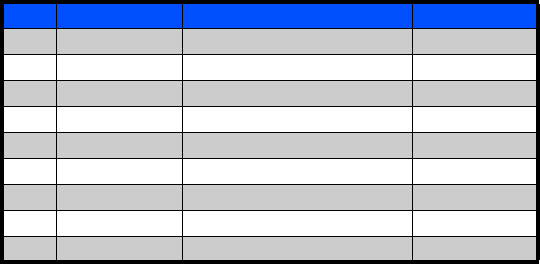
File name: e373.pdf
Software version:
No. Date Phone File name Reviewed by
1
2
3
4
5
6
7
8
9

Windows® XP and Windows® 2000 are registered trademarks of Microsoft Corporation
in the United States and/or other countries.
This product contains NetFront Internet browser software of ACCESS CO.,LTD.
This product contains JV-Lite2 Java virtual machine of ACCESS CO.,LTD.
This product contains AVE-SSL encryption module of ACCESS CO., LTD.
ACCESS, NetFront, JV-Lite and AVE are trademarks or registered trademarks of
ACCESS CO., LTD. in Japan and other countries.
This software is based in part on the work of the Independent JPEG Group.
You may not alter or reproduce, or remove from this product the Internet browser
software contained herein.
Use of the GIF decoder module contained in this product is permitted only as a part of
browser software, under a license from Unisys Corporation. For other use, you have to
obtain a separate license from Unisys Corporation.
Purchase and/or use of the browser software contained in this product does not
authorise your use of any other product or performance of any other method or activity
involving use of the LZW patents or GIF technology, unless you are separately licensed
in writing by Unisys Corporation.
Java, all trademarks and logos that contain Java are trademarks or registered
trademarks of Sun Microsystems, Inc.in the United States and other countries.
T9® Text Input is a registered trademark of Tegic Communications Inc.
T9® Text Input is licensed under one or more of the following: U. S. Pat. Nos. 5,187,
480, 5, 818,437, 5,945, 928, 5, 953,541, 6,011, 554, 6, 286,064, 6,307,548, 6,
307,549, and 6,636, 162, 6,646,573; Australian Pat. Nos. 727539, 746674, and
747901; Canadian Pat. Nos. 1,331, 057, 2,302, 595, and 2,227, 904; Japan Pat. No.
3532780, 3492981; United Kingdom Pat. No. 2238414B; Hong Kong Standard Pat. No.
HK1010924; Republic of Singapore Pat. No. 51383, 66959, and 71979; European. Pat.
Nos. 0 842 463 (96927260. 8), 1 010 057 (98903671. 0), 1 018 069 (98950708.2);
Republic of Korea Pat. Nos. KR201211B1and KR226206B1. People's Republic of
China Pat. Application Nos. 98802801.8, 98809472. X and 96196739. 0; Mexico Pat.
No. 208141; Russian Federation Pat. No. 2206118; and additional patents are pending
worldwide.
Licensed by QUALCOMM Incorporated under one or more of the following United
States Patents and/or their counterparts in other nations: 4,901,307, 5,490,165,
5,056,109, 5,504,773, 5,101,501, 5,506,865, 5,109,390, 5,511,073, 5,228,054,
5,535,239, 5,267,261, 5,544,196, 5,267,262, 5,568,483, 5,337,338, 5,600,754,
5,414,796, 5,657,420, 5,416,797, 5,659,569, 5,710,784, and 5,778,338.
The specifications and information in this manual are subject to change without notice.
Some contents in this manual may not apply to your phone depending upon the
software of the phone or your service provider.
Copyright Notice

Important Safety Informa-
tion1
Start-up 8
Basic Functions 18
Main Menu 25
Reference Information 54
Repair Guideline 55
This User Manual is printed by NEC Mobile Communicate Corporation
without any warrant. NEC Mobile Communication Co., Ltd reserves the right
to modify or improve this Manual for any printing error, discrepancy from the
latest data, program and equipment any time without separate notice, which,
however, will be incorporated into the latest version of the User Manual.
Note:
Some services/functions hereunder are not necessarily supported by all
networks, such as 112, the international emergency call number.
Please contact the network operator or service provider for clarification of
how to use specific service/function.
Please read "Safety and Performance" and "Maintenance Guideline"
chapters prior to the use of the mobile phone.
Important Safety Information 1
Start-up 8
Basic Functions 18
Main Menu 25
Reference Information 54
Repair Guideline 55

< ii
Important Safety Information 1
Start-up 8
e373 Overview ...................................................................................................... 8
Definitions of Buttons ............................................................................................ 9
Status Icons ........................................................................................................ 12
SIM Card and Battery ......................................................................................... 15
Charging Method ............................................................................................ 16
Basic Functions 18
On/off .................................................................................................................. 18
PIN and PUK Codes ........................................................................................... 18
PIN and PIN2 Codes ...................................................................................... 18
PUK Code and PUK2 Code ........................................................................... 19
Outgoing Call ...................................................................................................... 19
Number Keys .................................................................................................. 19
One-key dialing .............................................................................................. 19
Fast dialing ..................................................................................................... 19
Dial from phonebook ......................................................................................20
Dial the number through call options .............................................................. 20
Dial international call ...................................................................................... 20
Directly dial extension number ....................................................................... 20
Emergency call ............................................................................................... 20
Receive Calls ...................................................................................................... 21
Reject Calls ......................................................................................................... 21
Functions in Audio Session ................................................................................ 21
Hold ................................................................................................................ 21
Mute ............................................................................................................... 22
SMS ................................................................................................................ 22
Multi-party session ........................................................................................ 22
Functions in Video Session ................................................................................ 23
Hold ................................................................................................................ 23
Mute ............................................................................................................... 23
Audio/video ..................................................................................................... 23
Zoom .............................................................................................................. 23
Brightness ...................................................................................................... 23
Picture quality ................................................................................................. 23
Screen mode .................................................................................................. 24

iii >
Main Menu 25
Settings .............................................................................................................. 26
1. Phone ......................................................................................................... 26
2. Phone modes ............................................................................................. 27
3. Display ....................................................................................................... 28
4. Power saving ............................................................................................. 28
5. Calls ........................................................................................................... 28
6. Security ...................................................................................................... 29
7. Network ...................................................................................................... 30
8. Reset settings ............................................................................................ 31
9. Videophone ................................................................................................ 31
10. Profile ....................................................................................................... 31
Message ............................................................................................................. 32
1. SMS ........................................................................................................... 32
2. MMS ........................................................................................................... 34
Web browser ...................................................................................................... 37
Activate WAP browsing webpage: ................................................................. 37
Browse the web page .................................................................................... 39
Phone Book ........................................................................................................ 39
Camera ............................................................................................................... 43
1. Initiate camera/shooting function ............................................................... 43
2. Taking pictures ........................................................................................... 44
3. Shooting function options ........................................................................... 46
My Data .............................................................................................................. 47
Java™ ................................................................................................................ 48
Accessory ........................................................................................................... 50
SIM toolkit ........................................................................................................... 53
Reference Information 54
Input Text ....................................................................................................... 54
Repair Guideline 55

EMERGENCY SERVICES < IMPORTANT SAFETY INFORMATION 1
To make an emergency call in any country
• Ensure that your e373 is switched on and in service.
• Press the Send key to return to the Home screen if needed.
• Press 112 (or 999 within the UK or 000 in Australia) followed by the Send key. (When
the SIM card is not inserted or when the dial lock function is on, press the SK2
(EMRGCY). When the dial lock function is on, press 112 and SK1 (YES). Refer to
Locking your e373 section on page 26 for further instructions on emergency calls when
the key lock is on.)
Follow the instructions and do not end the call until told to do so.
2Tell the operator which service you require: Police, Ambulance, Fire Brigade, Coastguard
or Mountain Rescue Service. Give your location and, if possible, remain where you are to
maintain contact.
2The 112 emergency number service is available on every digital network service.
Alternatively, use 999 in the UK, or 000 in Australia. Note that these can only be used with
a valid SIM.
2Due to the nature of the cellular system, connection to emergency calls cannot be
guaranteed.
A phone contains delicate electronic circuitry, magnets and battery systems. You should
treat it with care and pay attention to the following:
• This phone is fitted with an internal battery that can only be replaced by a qualified
service engineer. There is a risk of explosion if the battery is replaced with an incorrect
battery type. Dispose of the used battery in accordance with the manufacturer's
instructions.
• Do not allow the phone, battery or accessories to come into contact with liquids or
moisture at any time. Do not immerse in liquid.
• Do not allow the phone, battery or accessories to come into contact with liquids or
moisture at any time. Do not immerse in liquid.
• Do not paint the phone.
Important Safety Information
Emergency services
General care

2IMPORTANT SAFETY INFORMATION > GENERAL CARE
• Do not drop, throw or subject the phone to rough treatment.
• Do not place the phone alongside computer disks, credit cards, travel cards and other
magnetic media. The information contained on disks or cards may be affected by the
phone.
• Do not leave the phone or the battery in places where the temperature could exceed 60
°C, e.g. on a car dashboard or a window sill, behind glass in direct sunlight, etc.
• Do not remove the battery while the phone is switched on.
• Take care not to allow metal objects, such as coins or key rings to contact or short-
circuit the battery terminals.
• Do not dispose of batteries in a fire. Dispose of Li-ION batteries at a Li-ION recycling
point. For more specific battery and power supply information, see pages 6 and 7.
• Do not put the battery in your mouth, as battery electrolytes may be toxic if swallowed.
• Do not attempt to dismantle the phone or any of its accessories.
• Do not put a battery into a microwave oven, dryer or high-pressure container.
• Do not let the battery come into direct contact with an electric outlet or cigarette lighter
charger. Use only authorised charger units.
• Do not pierce the battery with a sharp object such as a needle.
• When the battery is thrown away, be sure it is non-conducting by applying vinyl tape to
the (+) and (-) terminals.
• Do not disassemble or modify the battery.
• Do not solder the battery directly.
• Stop using the battery if you detect any abnormalities, such as odour, discolouration or
heat during use, charge or storage.
• Do not use the phone with a damaged or misshapen battery.
• In the unlikely event of a battery leak, take care to keep the battery discharge away
from your eyes or skin. If the leakage does come into contact with the eyes or skin,
please flush thoroughly in clean water and consult a doctor.
• Remove a worn out battery immediately.
• The handset itself may become warm when the handset is used for an extended period
of time or when the video functions are used. Also, it may become warm while the
battery is being charged.
• When a phone is set to Vibration mode, the vibration can sometimes cause your phone
to move. Be careful not to place the phone near heat sources (such as a heater) or too
close to the edge of the table.
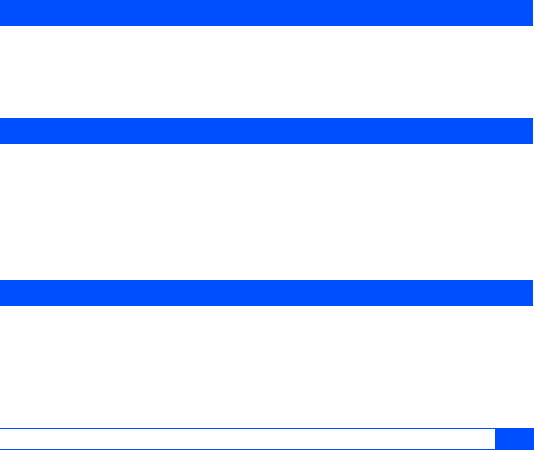
SAFETY < IMPORTANT SAFETY INFORMATION 3
• Use an anti-static cloth to clean the phone. Do not use an ordinary dry cloth or
electrostatically charged cloth. Do not use chemical or abrasive cleaners as these could
damage the case.
• Remember to recycle the cardboard packaging supplied with this phone.
• Remember to make backup copies of all important data on your phone.
• Do not leave the battery pack empty or disconnected for a long time, otherwise some
data may be initialised.
• Take care not to put your phone in your back pocket and then sit on it. Also, do not put
your phone at the bottom of a bag where it may subject to excessive weight or
pressure. Doing so may damage the LCD and camera lens and cause them to
malfunction.
• Hold the phone away from your ear when you
- Play video/music on the Multimedia Player
- Play the ringtune through the speaker.
• It may damage, or irritate your ears.
The use of mobile phones is not allowed in some radiation-sensitive areas, such as
hospitals, research centres and aircraft. Ensure that you switch off your phone in these
areas. If in doubt, remove the battery.
Switch off your phone and remove its battery when inside or near an aircraft. The use of
phones in aircraft is illegal. It may be dangerous to the operation of the aircraft and it may
disrupt the mobile network. Failure to observe this instruction may lead to suspension or
denial of mobile network services to the offender or legal action or both.
Do not use the phone on the ground without the permission of the ground staff.
Safety
Aircraft safety
Hospital safety

4IMPORTANT SAFETY INFORMATION > GENERAL SAFETY
Switch off your phone and remove its battery in areas where the use of phones is prohibited.
Follow the instructions given by the respective medical centre regarding the use of mobile
phones on their premises.
• Observe “Turn off mobile” signs, such as those near petrol stations, chemicals or
explosives and switch off your phone.
• If you have a heart condition, be careful with the call vibration or tone volume settings.
• Do not allow children to play with the phone, charger or batteries.
• Do not use the phone where blasting is in progress.
• The operation of some medical electronic devices, such as hearing aids and
pacemakers, may be affected if you use a mobile phone next to them. Observe any
warning signs and the manufacturer's recommendations.
• Your phone contains metal which may cause a skin irritation, a rash or eczema.
• You MUST exercise proper control of your vehicle at all times. Give your full attention to
driving.
• Observe all local safety regulations regarding the use of mobile phones while driving.
• Pull off the road and park before making or answering a call.
• You MUST NOT stop on the hard shoulder of a motorway to answer or make a call,
except in an emergency.
• Switch off your phone at a refuelling point, such as a petrol station, even if you are not
refuelling your own car.
• Do not store or carry flammable or explosive materials in the same compartment as a
radio transmitter.
• Electronic vehicle systems, such as anti-lock brakes, speed control and fuel injection
systems are not normally affected by radio transmissions. The manufacturer of such
equipment can advise if it is adequately shielded from radio transmissions. If you
suspect vehicle problems caused by radio transmissions, consult your dealer and do
not switch on the phone until it has been checked by qualified approved installers.
• Check if local laws and/or regulations restrict the use of phones while driving.
General safety
Road safety
Vehicles equipped with an airbag

THIRD PARTY EQUIPMENT < IMPORTANT SAFETY INFORMATION 5
An airbag inflates with great force. Do not place objects, including either installed or portable
wireless equipment, in the area over the airbag or in the airbag deployment area. If in-
vehicle wireless equipment is improperly installed and the airbag inflates, serious injury
could result.
The use of third party equipment, batteries, cables or accessories, not made or authorised
by NEC, may invalidate the warranty of your phone and also adversely affect the phone's
operation.
The phone, batteries and charger contain no user-serviceable parts. We recommend that
your NEC phone is serviced or repaired by an NEC authorised service centre. Please
contact 3 or NEC for advice.
The phone has an internal antenna. For optimum performance with minimum power
consumption, please do not cover the internal antenna area with your hand. Covering the
internal antenna affects call quality, may cause the phone to operate at higher power levels
than needed and may shorten talk and standby times.
Third party equipment
Service
Efficient use
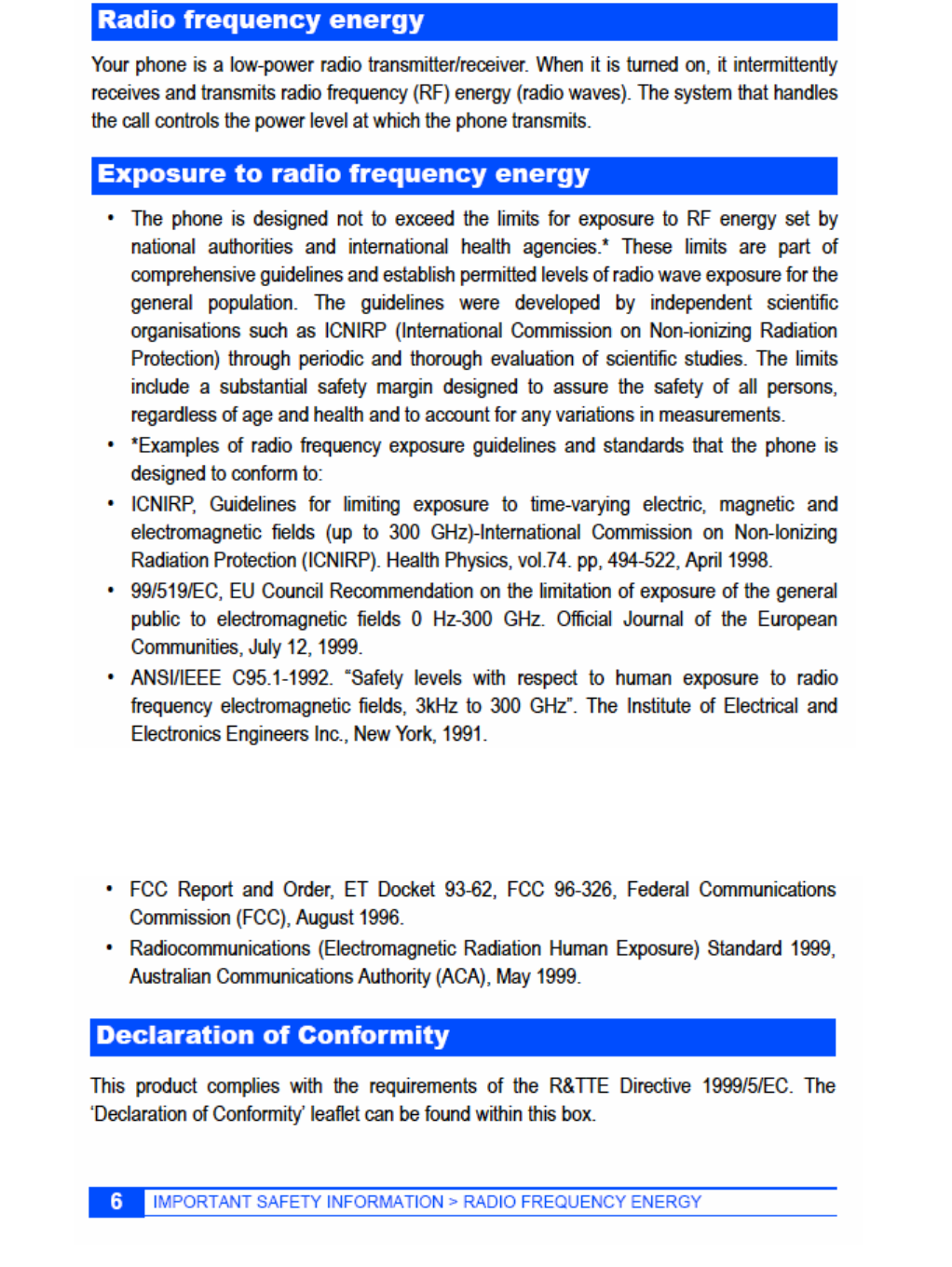
・For body worn operation, this phone has been tested and meets FCC RF
exposure guidelines when used with an accessory that contains no metal and
that positions the handset a minimum of 1.5cm from the body. Use of other
accessories may not ensure compliance with FCC RF exposure guidelines.
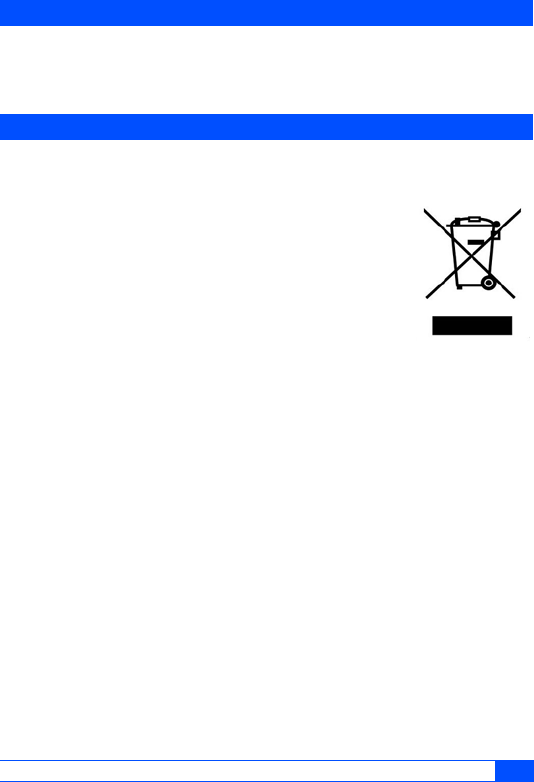
COPYRIGHT NOTICE < IMPORTANT SAFETY INFORMATION 7
The video/audio recordings you make/download are protected by copyright laws. They are
for personal use only and must not be otherwise used without the permission of the
copyright owner.
In the European Union
EU-wide legislation as implemented in each Member State requires
that used electrical and electronic products carrying the mark (left)
must be disposed of separately from normal household waste. This
includes mobile telephones or electrical accessories, such as
chargers or headsets. When you dispose of such products, please
follow the guidance of your local authority and/or ask the shop where
you purchased the product.
The mark on the electrical and electronic products only
applies to the current European Union Member States.
Outside the European Union
If you wish to dispose of used electrical and electronic products outside the European Union,
please contact your local authority and ask for the correct method of disposal.
Copyright Notice
Disposing of your used NEC product
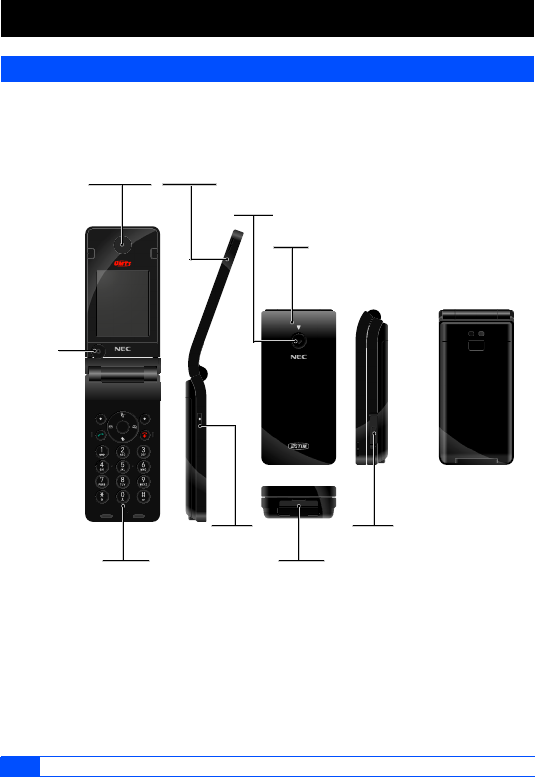
8START-UP > E373 OVERVIEW
1. Start-up
1.1 e373 Overview
Front lens
Headphone
Charger jack, dataline jack
Back lens
Microphone
Side key
LOUDSP
LED
Headset jack
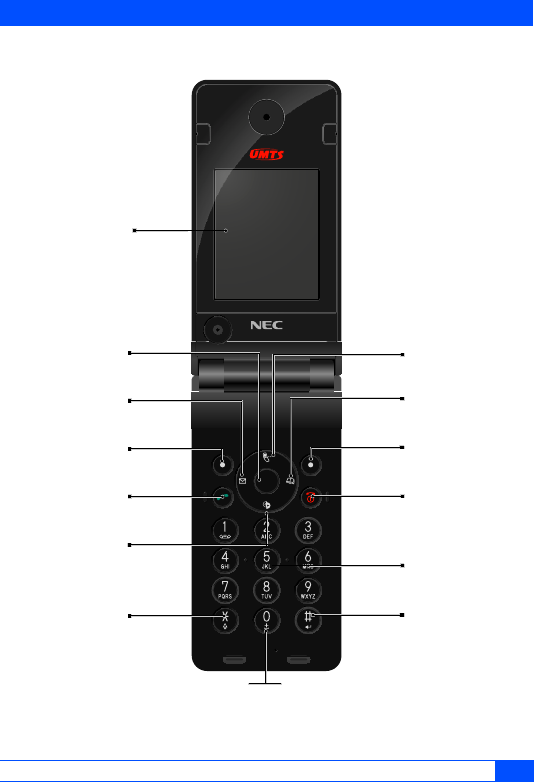
DEFINITIONS OF BUTTONS < START-UP 9
1.2 Definitions of Buttons
Display
OK key
Left navigation key
LSK key
Down navigation key
* key
Send key
Keyboard
# key
Letter/number key
Power key
RSK key
Right navigation key
Upper navigation key
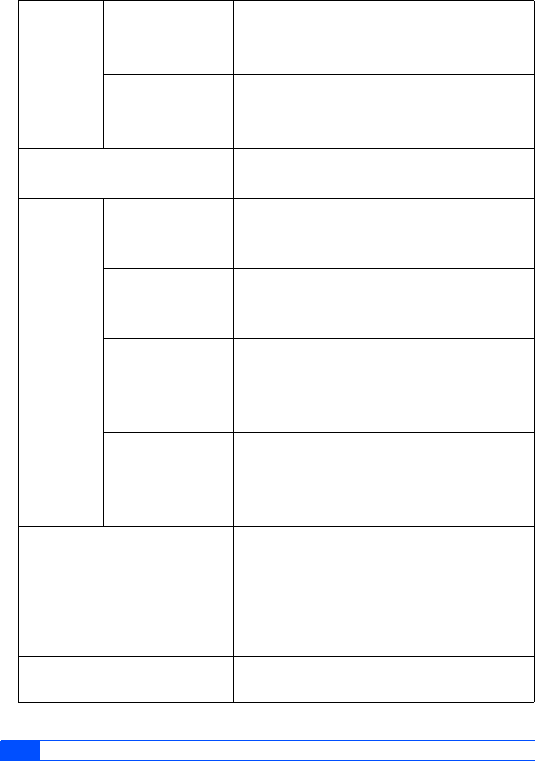
10 START-UP > DEFINITIONS OF BUTTONS
LSK/RSK
keys
LSK key Idle mode: enter into the main menu screen
Menu mode: select menu or pop-up menu
Editing mode: switch over the input methods
RSK key Idle mode: enter into main menu screen
Menu mode: back to the last page
Editing mode: clear off text and characters
OK KEY Idle mode: enter into main menu screen
Menu mode: select menu or confirm options
Direction
key
Upper
navigation key
Idle mode: directly enter into [Phone mode]
function
Menu mode: scroll the menu upward
Down navigation
key
Idle mode: directly enter into [My data]
function
Menu mode: scroll the menu downward
Left navigation
key
Idle mode: directly enter into [Message]
function
List mode: paging Forward
Editing mode: cursor leftward
Right navigation
key
Idle mode: directly open [Phone book] list
function
List mode: paging backward
Editing mode: cursor rightward
Send key Idle mode: directly enter into [Dialed calls]
function, press [RSK] could enter into
[Received calls] and [Missed calls] function
circularly
Dialing and incoming-call mode: dial or
receive calls
Power key Press it to hang up or cancel operations, hold to
turn on/off the e373
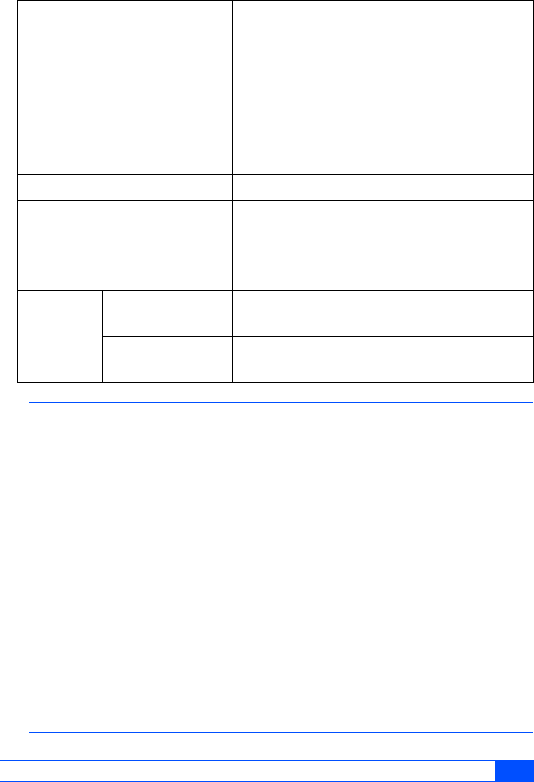
DEFINITIONS OF BUTTONS < START-UP 11
Letter/number key Idle mode: press it to input 0-9
Hold [number key 1] to call voice box
Hold [number key 2-9] to call the number
whose caller ID is corresponding number
registed in phone
Hold [number key 0] to input "+"
Menu mode: press it to enter into the
corresponding menu option
* key Idle mode: press it to input "*"
# key Idle mode: press it to input "#", hold it to input
suspended dialing symbol "P"
Editing mode: press it to display general
symbols
Side key Unfolded Idle mode: press it to set backlight on, hold it to
enter into camera function
Folded Idle mode: Check missed calls and new
messages
Note: the description about checking missed calls and new message as following:
The volume of notification tone and vibrator operation follows the ring tone
of the voice telephone or Phone mode setting.
New missed call or message:
If MP has missed call or new message, following behavior shall be applied.
Notification tone: Activate (Beep sound twice)
Vibrator: Activate for 1 sec, when setting of Vibrator is turned on.
LED: Turns on 5 sec (blue color)
No new missed call or message (No reminder icon)
If MP has no missed call or new message, following behavior shall be
applied.
Notification tone: Activate (Beep sound 3 times)
Vibrator: Activate for 0.2 sec, when setting of Vibrator is turned on.
LED: Blink 5 sec (Green color).
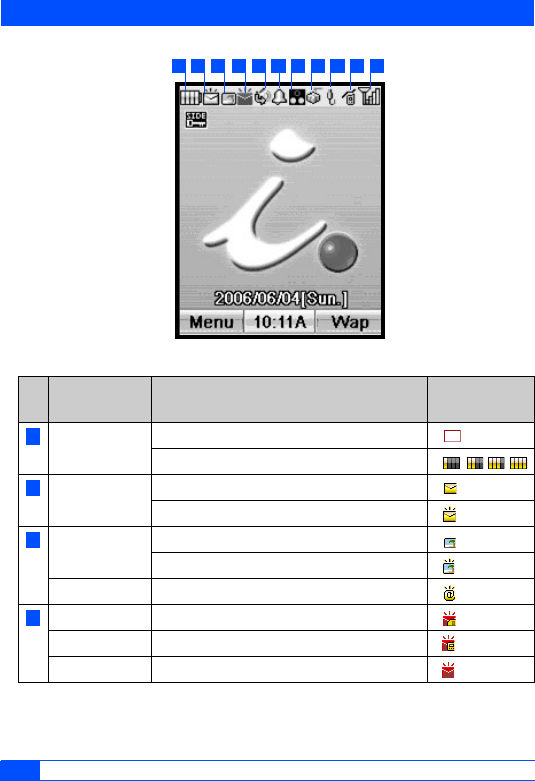
12 START-UP > STATUS ICONS
1.3 Status Icons
S
N
Meaning Simple description Icon
Battery
status
Low power
Power status
SMS status New short message
Un-read short message
MMS status New MMS
Unread MMS
WAP prompt WAP prompt
SIM card full SIM short message full
MP full MP short message full
SIM& MP full SIM card and MP short message full
13 191211 14 16 17 1111101815
11
12
13
14
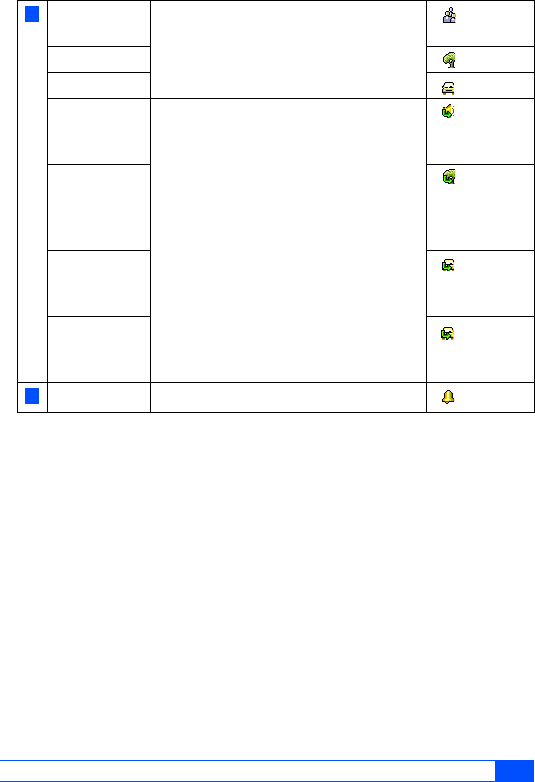
STATUS ICONS < START-UP 13
Meeting
mode
Display the Phone mode
Pocket mode
Car mode
Normal mode
and incoming
call transfer
Phone mode and incoming call transfer
Meeting
mode and
incoming call
transfer
Pocket mode
and incoming
call transfer
Car mode
and incoming
call transfer
Alarm clock Initiate the alarm clock
15
16
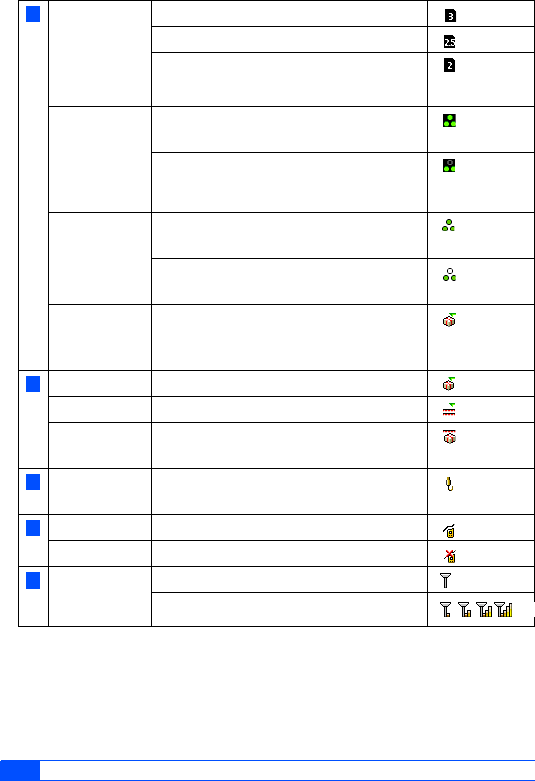
14 START-UP > STATUS ICONS
Display
network
coverage (i.e.
SIM card)
types
Display 3G SIM card in 3G network
Display 2.5G SIM card in GSM network
Display 2G SIM card in GSM network
Display
manual-
selected
network
types
Display SIM card compliant with 3G and
GSM manually chooses 3G network
Display SIM card compliant with 3G and
GSM manually chooses GSM network
Display auto-
selected
network
types
Display SIM card compliant with 3G and
GSM automatically chooses 3G network
Display SIM card compliant with 3G and
GSM automatically chooses GSM network
No auto
selection of
networks
Display no network signals of SIM card
compliant with 3G and GSM
PSD Packet switching mode
CSD Circuit switching mode
PSD&CSD Concurrent packet switching and circuit
switching
USB
connection
Display USB data line connected
Line attach Display data connection to the network
Line detach Display data disconnection to the network
Signal
display
Display failure to receive network signals
Display weak or strong signals
17
18
19
110
111
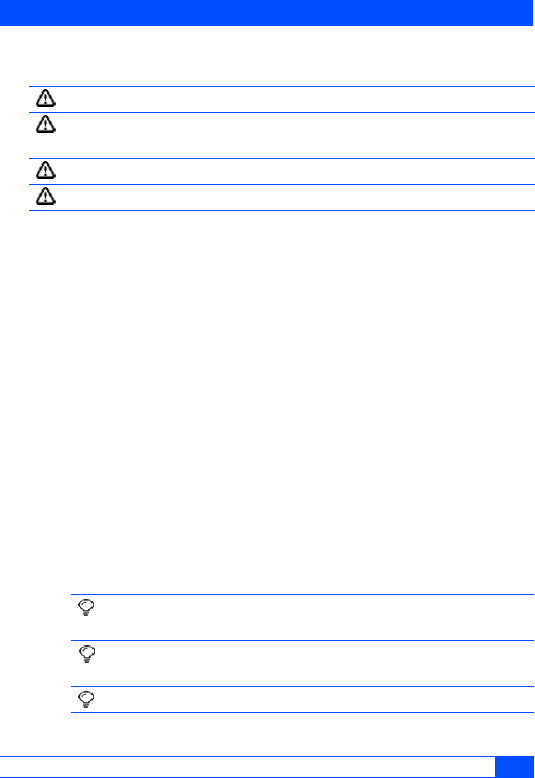
SIM CARD AND BATTERY < START-UP 15
SIM card (user ID mode) incorporates MP number and service items, and can store phone
numbers and personal data.
Get out the battery and install the SIM card as below:
1. e373 face up, palm up to hold the e373;
2. Push the battery back cover to the left to pop out;
3. Push the battery out with the thumb at the e373 back, get it out from the battery
cabin;
4. Insert SIM card into the slot by aligning the angles of SIM card with those of the
slot with the metal side facing down;
5. Insert the battery into the cabin top with the end with metal contact point
upward;
6. Press the other end of the battery to insert it fully into the cabin;
7. Push the back cover to the right until fully clinched.
To Remove the SIM Card
1. Ensure that the power is off. If the power is on, press and hold the End (On/Off)
key until power is off.
2. Remove the battery. (Refer to the illustration on the next page.)
3. Slide the SIM card out of the SIM card holder.
1.4 SIM Card and Battery
Caution: Place SIM card beyond the reach of children.
Caution: SIM card and the contact points are vulnerable to scratch or damage,
please gently handle the SIM card.
Caution: Place SIM card beyond the reach of static, dust or water.
Caution: Install SIM card when powering off e373 and getting out the battery.
Caution: Please contact the network service provider for any failure of
the SIM card.
Caution: The system environment, MP configuration and game
functions can all impact the idle-mode duration.
Caution: Battery Performance and Maintenance

16 START-UP > SIM CARD AND BATTERY
1. The e373 is charged by rechargeable charger.
2. Please note that the new battery can reach the best performance after two
or three full charging-discharging cycles.
3. The battery can sustain hundreds of charging-discharging cycles before
out of service. It is the time to replace the battery upon obviously shortened
working time of the battery (session duration and idle time).
4. Please adopt the battery and charger approved by the e373 manufacturer
to ensure the service life of e373; the battery equipped with the e373 is
rechargeable Li-battery. Please do not connect the battery with the charger
for over a week, as over-charge will shorten its service life; the charged
battery will discharge over time when idle for long.
5. Over high or over low temperature will impair the battery charging.
6. Do not use the battery for other purposes.
7. Do not use any damaged charger or battery.
8. Do not short-circuit the battery; the backup battery in pockets or bags may
touch the metal articles (coins, brooches or pens) that may connect the “+”
pole and “-“ pole of the battery (i.e. the metal bar on the battery) and lead to
short circuit, which may damage the battery or connections.
9. Keeping the battery in over hot or cold environment will shorten the life
service or reduce the capacity of the battery; keep the battery in
environment between 0°C and 45°C; otherwise the e373 may suspend
operation even fully charged.
10. Do not throw battery into fire.
11. Please dispose of the battery as required (recycled), do not dispose of
battery as living rubbish.
12. When not using the battery for a long period, remove it from the e373 and
store in a place with low humidity and low temperature.
Charging Method
When battery voltage is lower than the operating voltage, the screen will display charging
prompt and empty-battery icon with prompt tone and information, and the e373 will
automatically turn off after a while.
The e373 is equipped with the rechargeable Li-battery; please adopt original-manufacturer
charger and battery to ensure the e373 service life.
1. Carefully insert the pins of the charger to the jack at the profile of the e373.

SIM CARD AND BATTERY < START-UP 17
2. Connect the charger with the power supply when the e373 is shut off, the screen
will display “charging”. In case of charging when turning on, the battery icon will
flash with the voltage grids rising, the e373 operates normally. During charging,
the Illumination is light all the while, and the light coloris red.
3. After charging, the battery prompt icon will not flash, and the Illumination will not
be light; In case of charging when turning on, the screen will display “charging
completed”.
4. Disconnect the charger from the power supply and e373.
5. Please adopt the charger approved by e373 manufacturer, and refer to charger
manual prior to use.
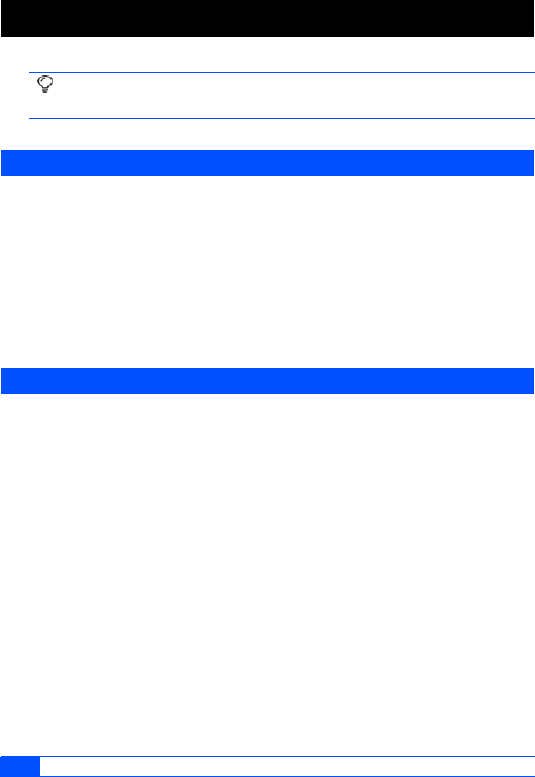
18 BASIC FUNCTIONS > ON/OFF
PIN and PIN2 Codes
2. Basic Functions
Caution: The e373 supports audio and video session in 3G network, and supports
only audio session in GSM network.
2.1 On/off
Power
on
Press [Power] for 2-3 seconds to power on e373 while seeing power-on
animation or text. Then the e373 will prompt you to input PIN code if applicable. It
will prompt you to input the lock password if applicable. When not inserting SIM
card, the e373 will prompt you to insert the card, but allow calling of emergency
numbers.
Power
off
Hold [Power] for seconds until you see the power-off picture.
2.2 PIN and PUK Codes
PIN
code
Avoid unauthorized use of SIM card. If initiating the power-on Pin code function,
the MP will require the PIN code when powered on, SIM card will be
automatically locked and display the lock prompt when inputting three wrong PIN
codes. The PIN code digits are 4-8.
PIN2
code
If inputting 3 wrong PIN2 codes in a row, the MP requires PUK2 code for
unlocking.
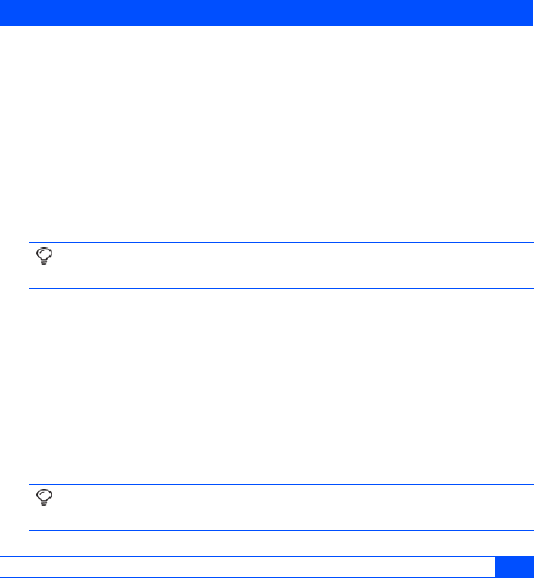
OUTGOING CALL < BASIC FUNCTIONS 19
PUK Code and PUK2 Code
Number Keys
The max number can be inputed in the idle screen is 57 digits and user can’t change to
another line manually. Input phone number in the idle screen with number keys, then press
[send key], then dial the audio call to such number; dial video call to such number by
pressing [OK].
One-key dialing
In idle mode, hold “1” to dial audio voice mail.
In idle mode, hold number keys 2-9, directly dial the numbers 2-9 stored in SIM card by
audio call.
Fast dialing
You can directly dial the numbers stored in SIM card or MP without inputting the numbers.
1. In idle mode, Input the number then press “*” key, the screen will display the
phone number stored in the MP.
2. In idle mode, input the number then press "#" key, the screen will display the
phone number stored in SIM card.
3. Press [send key] to dial audio call to the number; press [OK] to dial video call to
such number.
PUK
code
When modifying locked PIN code, MP requires PUK code (personal unlocking
code that is issued with SIM card. Please contact with the service provider for
PUK code otherwise. In case of inputting 10 wrong PUK codes in a row, the SIM
card will be permanently locked. Users are prohibited from changing PUK code;
users should contact the service provider for lost PUK code.
PUK2
code
PUK2 code is not supplied with SIM car, is needed when modifying the locked
PIN2 code. If inputting 10 wrong PUK2 codes in a row, the user is prohibited
permanently to use the menu options of PIN2 code.
2.3 Outgoing Call
Caution: If you dial an empty number, i.e. not stored in SIM card or MP, the MP
will prompt “No matching contact”.
Caution: If you dial an empty number, i.e. not stored in SIM card or MP, the MP
will prompt failure to find such contact in the current position.
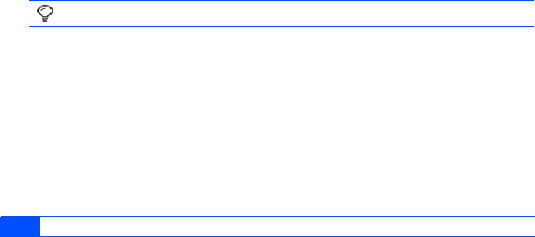
20 BASIC FUNCTIONS > OUTGOING CALL
Dial from phonebook
Search for a number in the telephone book, press [send key] to dial the audio call to such
number; or dial video call to the number in the menu.
Dial the number through call options
Search for the session lists in the session options, or in idle screen, press [send key] to
search for the dialed numbers, press [send key] again to dial audio call to such number, or
dial video call to the number in the menu.
Dial international call
Add international call prefix "+" in front of the number (pressing "0" for seconds, "+" will
display on the number column, then input nation code and telephone number, press send
key for the call.
Directly dial extension number
The MP permits direct dialing of extension number or voice mail. You can insert a
suspension symbol "P" between the phone number and extension number. In this case, the
MP will suspend the dialing of extension number until the response of the receiving party.
The "P" shall be inserted as below:
1. In general dialing practice, input the telephone exchange number, then hold "#"
key to input "P", then extension number.
2. Then press "send key" to dial the number, MP will automatically dial the
extension number when connected with the telephone exchange.
Emergency call
Your service provider configures your MP with one or more than one emergency numbers
(e.g. 112). In the service coverage area, the users can input the emergency number, then
press the send key to call emergency numbers even without the SIM card.
Caution: The function entails the network support.
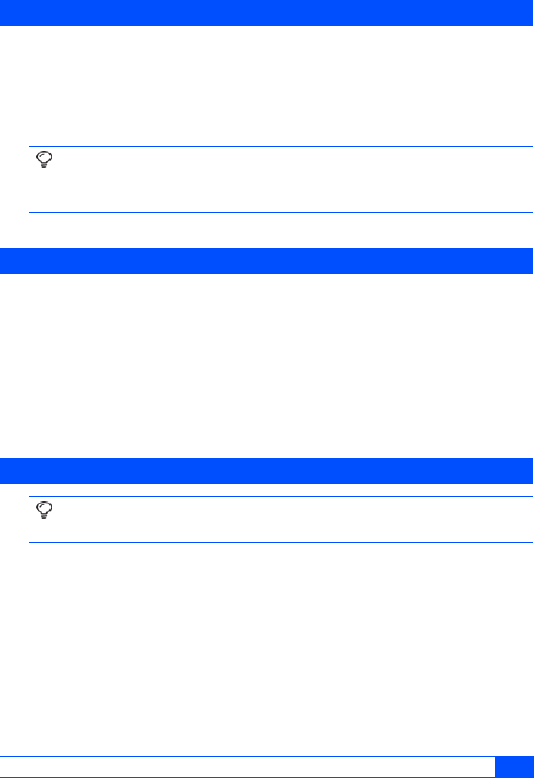
RECEIVE CALLS < BASIC FUNCTIONS 21
The MP will ring or vibrate when incoming calls, answer calls by pressing [OK] and [send
key], [LSK] is mute and cancel the vibration function, if configured any-key answer function
and the MP is folded, [Side key] is mute and cancel the vibration funtion. If configured any-
key answer function, you can press any key other than [RSK], [LSK] and [Power] to answer
calls. The received numbers are stored in the received number calls.
Press [RSK] and [Power] to reject incoming calls.
If you have not inserted the earphone Handset Connector, you can reject the call by fold the
MP.
If you have inserted the earphone Handset Connector, you cann't reject the call by fold the
MP.
In case of having not received incoming calls, the icon of the non-received calls will display
on the screen.
In the session, you can conduct many operations. In the session, press [LSK] to enter
into the session menu, including Hold, Mute, New SMS, enter phonebook etc.
Hold
During the session, press [LSK] to enter into in-session menu to keep the call by pressing
"Hold", when you can dial another number. Press LSK key and select "switch-over", the
current call is sustained and the Hold call becomes the current call; you can talk with either
party of the two, but only one party can hear you.
2.4 Receive Calls
Caution: If you have inserted the earphone Handset Connector, you can press
the button on it to answer incoming calls, when the keys of the MP can
still normally operate.
2.5 Reject Calls
2.6 Functions in Audio Session
Caution: The function depends on the support of network service provider and
whether you have registered the function.
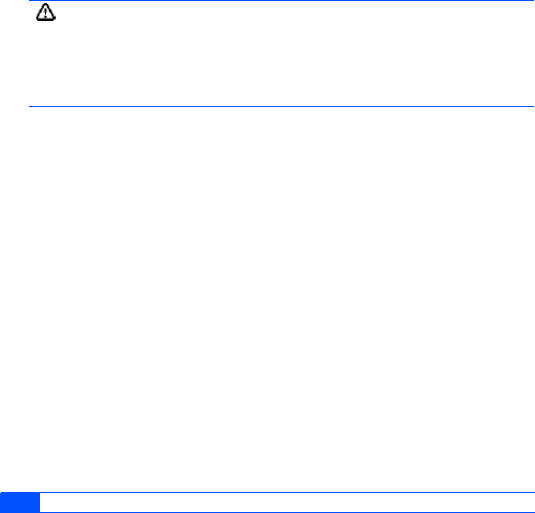
22 BASIC FUNCTIONS > FUNCTIONS IN AUDIO SESSION
Mute
During the session, press [LSK] to enter into in-session menu; in case of suspension of the
mike, select "Mute" when the other party cannot hear you; to restore the session, press
[LSK] and select "turn off silent tone".
SMS
In one call, two calls or telephone conference, press [LSK] to enter into the in-session menu,
select SMS, and conduct relevant operations; you can edit it or make selections in the phone
book.
Hand-free session
In the session, press [OK] for hand-free session.
Multi-party session
1. Multi-party conference
Please follow the steps below for multi-party conference:
1. Dial the number of one party;
2. Dial the number of another party, see the provisions of "Functions in Session";
3. Press "LSK key" to select "Conference"; you can conduct multi-party session
with the current session and maintained session. To dial more numbers to add
the parties; receive incoming calls in the session while maintaining the multi-
party session; press "LSK key" to select "telephone conference", you can
conduct the new multi-party session with the added numbers and maintained
numbers.
4. The maximum parties are 6. It bases on the network operator service.
2. Isolate multi-session parties
1. Press "LSK key" to select "isolation";
2. Select the number or numbers to be isolated (name or number);
3. Press "LSK key" to select "Split", then return to the session status;
Caution: The function depends on the support of network service provider and
whether you have registered the function. The function can connect
with the current session and maintained session to hold multi-party
session. In the session, all parties can hear the talking party. You can
add or separate the parties based on needs.
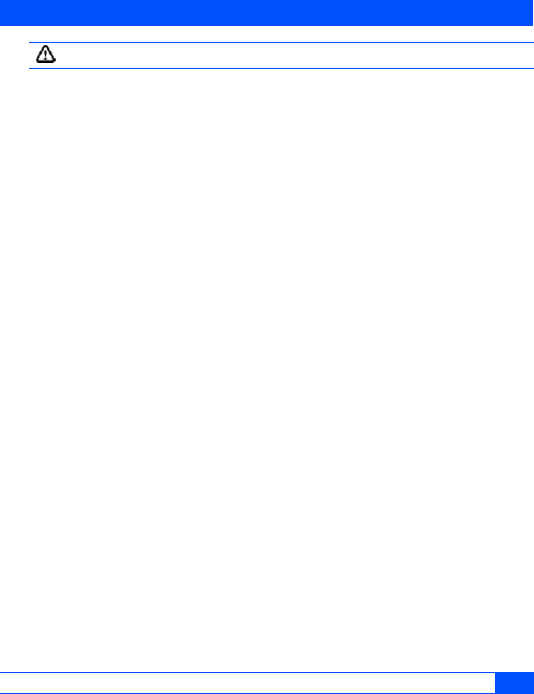
FUNCTIONS IN VIDEO SESSION < BASIC FUNCTIONS 23
4. You can then talk with the isolated party (maintain the session with other
parties), then disconnect the number, then conduct multi-party session with the
maintained parties (or hold on the isolated number, press "LSK key" to select
"add" to conduct multi-party session.)
Hand-free Session
In the session, press [OK] to realise hand-free function, or press "LSK key" to enter into the
in-session menu to select the hand-free option.
Front camera/Rear camera
The MP supports dual lens; in the session, press "LSK key" to enter into the in-session menu
to select "Front camera" or "Rear camera" for video session.
Hold
During the session, press [LSK] to enter into the in-session menu to select "Hold", the
maintained party will not hear your audio or video data.
Mute
During the session, press [LSK] to enter into in-session menu to select "Mute" to shut off the
mike, or press [LSK] to select "shut off silent tone" to restore session.
Audio/video
During the session, you can send video or static pictures; press [LSK] to enter into in-
session menu, select "Use photo instead" to send static picture to the other party; select
"Use video instead" to make video session.
Zoom
During the session, press [LSK] to enter into in-session menu; select "Zoom" to define lens
focus levels 1, 2 and 4.
Brightness
During the session, press [LSK] to enter into in-session menu; select "Brightness" for
brightness levels +2, +1, 0, -1 and -2.
Picture quality
During the session, press [LSK] to enter into in-session menu; select "picture quality" to
configure quality levels as Normal, Fine and Super fine.
2.7 Functions in Video Session
Caution: Video phone session is only available in 3G network.

24 BASIC FUNCTIONS > FUNCTIONS IN VIDEO SESSION
Screen mode
During the session, press [LSK] to enter into in-session menu; select "screen mode" to
configure screen modes as "My side is smaller", "My side is larger", "Other side only" or "My
side only".
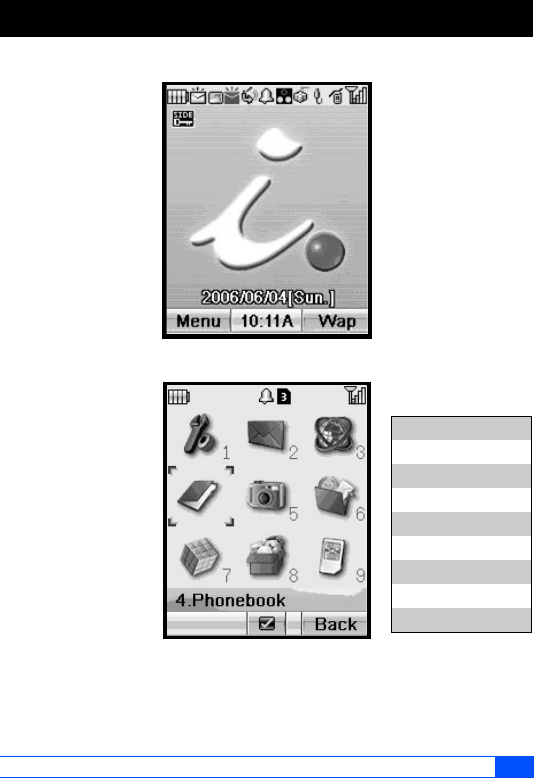
< MAIN MENU 25
Press [LSK] in the idle screen.
In the main menu, select the 9 options by [direction navigation key]:
3. Main Menu
1. Settings
2. Message
3. Web Brower
4. Phone book
5. Camera
6. My data
7. Java™
8. Accessory
9. SIM toolkit

26 MAIN MENU > SETTINGS
Press [direction navigation key] to switch over the sub-menus, then press [OK] or relevant
number key for confirmation.
The default configuration of your MP will enable to use the functions immediately after
inserting SIM card. For more needs and application modes, this MP allows you to define and
change the setting for your habits to meet senior communication needs.
1. In the idle screen, press [LSK] to enter into the menu.
2. Press [direction navigation key] to scroll to [1.Settings], then press [OK] for
confirmation (or press [number key1]).
The system settings menu includes:
1. Phone
2. Phone modes
3. Display
4. Power saving
5. Calls
6. Security
7. Network
8. Reset settings
9. Videophone
10. Profile
Each setting covers multiple setting items allowing selecting or inputting setting values,
which create the automatic control of the MP.
1. Phone
MP settings make setting based on the MP service status, including Ring, Answer option,
Clock, Illumination, Side key guard, language.
1. Ring: the option window provides Voice call ring, Video call ring, Message ring,
Volume, Alert tone, to be selected by [up and down navigation key].
2. Answer options: configure whether to respond to incoming calls by any key.
Note: 1. If the wallpaper is calendar, banner won't be disapplyed.
2. [9. SIM toolkit] display will vary with SIM cards.
3.1 Settings
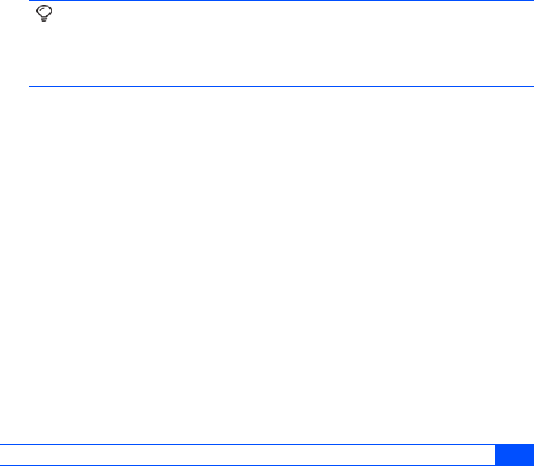
SETTINGS < MAIN MENU 27
3. Clock: Configure time and date and the formats by [up and down navigation
key]. Press [OK] to determine the modification contents.
-Set time: allows input of correct time;
-Set date: allows input of correct date;
-Set time format: adjust the date display format in12/24-hour system;
-Set date format: adjust the date display formats of 6.
4. Illumination: configure the color of Illumination
Color settings:
-Voice call: configure the color of Illumination for receiving voice call
-Video call: configure the color of Illumination for receiving video call
-MMS: configure the color of Illumination for receiving MMS
-SMS: configure the color of Illumination for receiving SMS
During call: configure the color of Illumination during voice call and video call.
-On: configure the status of Illumination On during voice call and video call,
and the color is according to the setting of receiving call.
-Off: configure the status of Illumination Off during voice call and video call.
5. Side key guard: configure the side key lock or not. This function is valid only
when the MP is folded close.
6. Language: configure the current menu and prompt language as English and
Italian.
2. Phone modes
In the scene mode screen, select an option among Normal Mode, Meeting Mode, Pocket
Mode or Car Mode. Then the MP will follow the selected mode in operation. Pressing [LSK]
can edit the highlight item as following.
Caution: During Ring tone selection, clock alarm, clock alarm tone selection,
schedule alarm, schedule alarm tone selection, melody play(Mydata,
Browser, MMS attachment), the color of Illumination is according to the
setting of voice call.
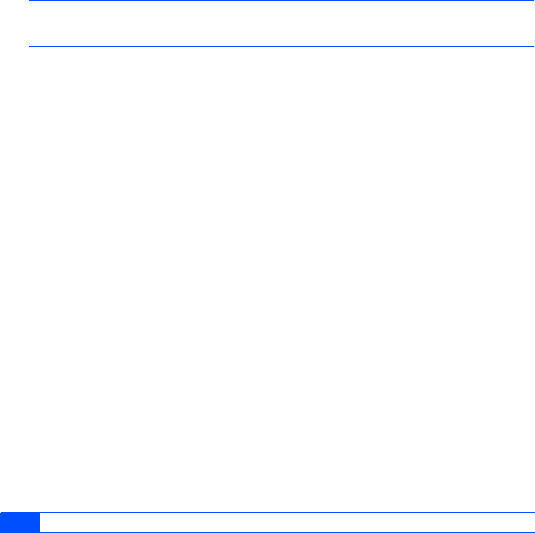
28 MAIN MENU > SETTINGS
1. Normal mode
In the scene mode screen, select the desired working mode, then configure the parameters
as per your personal taste, including the following setting items:
-Ring volume: adjust the tone volume
-Keypad volume: "press key volume" can adjust the volume of key pressing;
-Earpiece volume: "headphone volume" can adjust the headphone volume in
dialogue, or adjust it by direction navigation key in session;
-Message volume: adjust the information prompt volume;
-Ring tones: select voice calls, video calls and message;
-Vibration pattern: 3 types, or "shut off vibration";
-Other settings: select key tones, coverage tone and auto answer.
3. Display
Display screen setting covers Greetings, wallpaper and idle banner.
-Greetings: screen display upon power on; including no greeting, text and animation,
"text" option allows user editing in the editing screen.
-Wallpaper: select the favorite pictures from the pictures stored in the MP, camera
pictures and download pictures, as the background paper; to configure the
background paper, enter into the picture base to select the favorite.
-Idle banner: display on the idle screen; you can edit it by text editing window.
4. Power saving
Power saving mode: Include two items, i.e. backlight setting, backlight timer.
- Backlight setting: setting of backlight brightness, high, middle and low levels.
- Backlight timer: setting of backlight duration.
5. Calls
1. Call divert
A network function for forwarding the call to designated phone as requested by the user.
Upon the setting, MP requires you to input the designated number to receive the call. If
failing to receive the transferred call, please check the destination number.
-Divert always: with the setting, all incoming calls will be transferred to designated
number.
Note: Meeting mode, Pocket mode, Car mode setting items is the same as Normal
mode.

SETTINGS < MAIN MENU 29
-On busy: with setting, the incoming calls will be transferred to designated number
when MP is busy.
-No reply: with this setting, the incoming calls will be transferred to designated
number when MP does not respond.
-Unreachable: with this setting, the incoming calls will be transferred to designated
number when MP upon failure of connection (e.g. poor network signal or poor
signaling environment).
-Cancel all: with this setting, the transfer setting will be cancelled.
2. Call waiting
Whether to permit call waiting; shut off this function, the calling party will hear busy tone
when the other party is busy.
3. Auto redial
Whether to permit re-dial; if shutting off this function, MP will not re-dial in case of connection
failure.
4. Call barring
You can configure the following call prohibitions to help enhance the safety; the network
operator provides a 4-digit password to you for prohibiting calls.
-All outgoing: prohibit all outgoing calls.
-Int'l call: prohibit international call.
-Int'l EXPHome: prohibit dialing of local number when overseas roaming.
-All incoming: prohibit all incoming calls.
-Int.in calls prohibit: prohibit all incoming calls upon roaming.
-Cancel all: cancel all restrictions when inputting restriction password.
-Change password: first input the existing code, then the new codes twice.
5. Caller ID
Restrict the calling number display, including 3 items, i.e. Network default, Hide number and
Send number.
6. Security
Safety setting can configure and modify passwords and options to prevent non-authorized
use of MP and restriction of MP use, including initiating PIN code, modifying PIN code,
power-on locking, modifying MP lock password, present locking and Fixed numbers.

30 MAIN MENU > SETTINGS
-PIN activate: With PIN code function, input the PIN code upon power on. In case of
inputting three wrong PIN codes in a row, the SIM card will be automatically locked
and display the locking information.Initial PIN code is 0000.
-Change PINs: modify PIN code, PIN2 code. PIN code can prevent unauthorized use
of SIM card. Generally, PIN2 code is not provided with SIM card, as it provides
special network service.
-Power on lock: With the power-on locking function, input the password when
powering on.
-Change Sec. Code: first input the existing code, then the new codes twice.
-Phone lock: lock MP to prevent MP data disclosure; use the MP by inputting
password. Initial phone lock code is 1234.
-Fixed numbers: initiate fixed numbers dialing.
7. Network
The menu has 4 options, i.e. select mode, new searching, priority network and access
networks order.
1. Search type:
-Automatic: Upon power-on, MP will register to the first service network in the
network sequence list, and will attempt the next upon any failure.
-Manual: first retrieve all networks and recognise the registration icons of each
network; then select one network for registration, MP will automatically register into
the next network upon failure.
2. New search
Retrieve all networks and recognise the registration icons of each network; then select one
network for registration.
3. Preferred network
In the network list, you can operate the listed networks; select "priority network" in the
"network service", enter into the priority network display to display priority network list, you
may browse through the network details, insert new priority network to the end of the list;
meanwhile you can delete the priority network from the list.
4. Network mode
Provide the selection of network access orders, including Automatic, WCDMA only and GSM
only.

SETTINGS < MAIN MENU 31
8. Reset settings
Select the option; you can restore the MP settings to ex-work setting.
9. Videophone
During the video session, you can configure the communication needs, including camera
setting, video call option and video call service.
1. Camera settings:
Setting of camera parameters in video session.
-Screen mode: setting of the screen display in video session, including my side is
smaller, my side is larger, Other side only, my side only.
-Picture quality: configure the display speed of the picture, including Standard,
Better picture, Faster movement.
-Camera mode: setting of camera display mode, including default, sepia and
monochrome.
2. Video call options:
Setting of picture display, including video settings and show timer.
-Video settings: setting of live video or photo video.
-Show timer: setting of the time display.
10. Profile
The setting and display of network parameters, you can edit your own network access
parameters.
In the interface of editing data connection mode, you can configure 16 modes each
corresponding to a set of parameters.
-Name: Display the name of the data connection mode.
-APN: cmwap for country Mobile.
-IP: IP address provided by operator.
-Primary DNS: input primary DNS server address
-Secondary DNS: input secondary DNS server address
-Security: Set the security for network, include None, PAP and CHAP;
In the interface of Select active data profile, you can select profile of MMS, JAVA or Web
browser application. For each application, you can select one of the 16 modes for network
access services.

32 MAIN MENU > MESSAGE
In "Message" application, you can create, send, receive, browse, edit and sort "short
message" and "MMS".
1. SMS
1. Create and send short message
1. In "SMS" screen, press [LSK] to enter into the new interface.
2. In the new short message interface, select "Add new" to input new numbers,
press [down navigation key] to select from the phone book list; select "Canned
Msg" to input short message contents.
3. In the new short message interface, press [LSK] to pop up the menu, press [up
and down navigation key] to select [send] or [save].
[send]-the MP will send out the short message to the number.
[save]-store the message into the "Drafts" box list.
4. The MP allows selection of more than one contact in the number list; each
contact can be selected from [Mobile number], [home number], [office
number], then return to the contact list interface.
2. Read SMS
In idle mode, press [Left navigateon key] to directly enter into message main screen ; In
SMS main screen; select [1 Inbox], [2 Outbox], [3 Sent], [4 Drafts] menu, enter into the
message list; press [up and down navigation key] for scrolling list inquiry. Press [OK] to
read the message and relevant information, such as receiving number and sending number,
date and time.
-Inbox: store the received messages.
In the message list, press [LSK] to execute the operation below:
Read: See details of the received message.
Delete: delete the message from Inbox.
Delete all: delete all messages in Inbox.
-Outbox: store messages failing to be sent out.
In the message list, press [LSK] to execute the operations below:
Read: examine the details of message not sent out yet.
Delete: delete selected message from the Outbox.
Delete all: delete all messages form the Outbox.
3.2 Message

MESSAGE < MAIN MENU 33
-Sent: store the sent messages.
In the message list, press [LSK] to execute the operation below:
Read: read details of sent message.
Delete: delete selected message from the Sent.
Delete all: delete all sent messages.
-Drafts: store messages for future use.
In the message list, press [LSK] to execute the operation below:
Edit: edit message detail in the draft box.
Delete: delete selected message from the draft box.
Delete all: delete all messages from the draft box.
3. Voice mail
By "voice mail" function, you may forward the incoming calls to the voice mail center, and the
calling party can leave a message in the mailbox, then you will receive the notice message.
The service provider can provide such number to you, and you can configure and modify the
number.
4. Settings
Short message setting, including short message service center, short message valid term,
status report, storage type, community broadcast, templates.
-Service center: the number is provided by MP service provider. Once you key in a
short message service center number, the number will be displayed on the screen;
you can modify or delete the number; you shall first key in the number with such
option prior to sending short message.
-Expire period: setting of message validity term to determine the stay duration in the
message center prior to deletion, e.g. 1 hour, 6 hours, 1 day, 3 days, 1 week and the
maximum.
-Status report: activate or deactivate report function; when activated, the network will
notify you the message sending status.
-Storage type: select short message storage type: SIM card and Phone; if you select
SIM card storage, the short message will be automatically stored to SIM card.
-Broadcast: the function of group broadcasting through MP service network; activate
the function in "option" menu; in "channel" menu, press [LSK] to create, edit or delete
the channel number.
-Canned message: the examples of some SMS sentences for reference and editing.

34 MAIN MENU > MESSAGE
5. Memory status:
Display free room you can store and total roomage in SIM and Phone.
2. MMS
The MMS may include text, picture and audio clips. The received or sent MMS shall not
exceed 300k, otherwise the MP will reject the mail. Upon incoming new mail, the MMS
center will send the notice message to you, and you can decide on receiving or rejecting it.
1.Create Message
1. In Message Type Select, select "Video Message" and "SMIL Message".
2. In the new Video Message interface, select "add contact" to input new number
or email box, Press [up and down navigation key] to switch over among
"subject", "attention", "cc", "attachment", options; select "Sub" to enter into the
text edit interface, input mail subject.
3. In the new MMS Message interface, select "add contact" to input new number or
email box, Press [up and down navigation key] to switch over among
"subject", "attention", "cc", "attachment", "new SMIL" options; select "Sub" to
enter into the text edit interface, input mail subject; select "Create SMIL" for
content editing.
4. In the new Video Message and SMIL Message interface, press [LSK] pop-up
menu, press [up and down navigation key] to select [Edit], [Send], [Save],
[Send Option].
[Edit]- Add receiver upon vacancy; otherwise, enter into the receiver list to
search for or edit all contact numbers.
[Send]- The MP will send out the SMIL to the input number or email box.
[Save]- Store the message to " Drafts" list.
[Send Option]-Configure Message Priority, Delivery Report, Deliver Time.
In the "Create SMIL" editing interface, you can insert picture, tone and text.
You can edit slide timing. Press [LSK] pop-up menu, Press [up and down
navigation key] to switch over among the following options:
[Remove]: remove picture, tone, or text.
[Add Slide]: add new frame.
[Insert Slide]: insert a frame between two.
[Delete Slide]: delete a frame.
[Preview Slide]: pre-view the frame.
[Preview]: pre-view all contents and effect of the SMIL.

MESSAGE < MAIN MENU 35
[Slide Options]: Configure Image Timing, Sound Timing, Text Timing,
Image Fit Mode.
5. It may take longer to send a SMIL than a short message. Upon sending failure,
the SMIL well be stored in "Outbox" for attempt of re-sending.
2.Read MMS
1. In idle mode, press [LSK] to enter into the menu list, select "message" option;
select [2 MMS], enter into the menu list; press [up and down navigation key]
to scroll the list for inquiry, press [OK] for function options.
2. Inbox: store the notices or the received MMS.
In the message list, press [LSK] pop-up menu for operation below:
Open: read details of received notices or MMS.
Reply: automatically add the sender number or mailbox address to the
receiver column in the MMS editing interface.
Reply all: automatically add the sender or receiver number or mailbox
address to the receiver column in the MMS editing interface.
Forward: forward the MMS to other parties.
Move: move the notices and MMS
Delete: delete the selected notices or MMS from Inbox.
Delete All: delete all notices and MMS in the Inbox.
Sort: queue the notices and MMS as requested
Filter View: extraction of specified message
-Outbox: store MMS failing sending.
In the message list, press [LSK] pop-up menu for operation below:
Edit: re-edit MMS content.
Delete: delete selected MMS from the Outbox.
Delete All: delete all MMS in the Outbox.
Sort: queue MMS as requested
Filter View: extraction of specified message
-Drafts: store MMS not sent or save.
In the message list, press [LSK] pop-up menu for operation below:
Edit: re-edit MMS content.
Delete: delete selected MMS from the Drafts.

36 MAIN MENU > MESSAGE
All delete: delete all MMS in the Drafts.
Sort: queue the MMS as requested.
Filter View: extraction of specified message
-Sent : store MMS successfully sent out.
In the message list, press [LSK] pop-up menu for operation below:
Open: read the sent messages.
Edit: re-edit MMS content.
Delete: delete selected MMS from the sending box.
Delete All: delete all sent SMILs.
Sort: queue the MMS as requested.
Filter View: extraction of specified message
-My folders: store the notices or the received MMS.
In the message list, press [LSK] pop-up menu for operation below:
Open: read details of received notices or MMS.
Reply: automatically add the sender number or mailbox address to the
receiver column in the MMS editing interface.
Reply All: automatically add the sender or receiver number or mailbox
address to the receiver column in the MMS editing interface.
Forward: forward the MMS to other parties.
Move: move the notices and MMS
Delete: delete the selected notices or MMS from Inbox.
Delete All: delete all notices and MMS in the Inbox.
Sort: queue the notices and MMS as requested
Filter View: extraction of specified message
3.Select a SMIL in inbox or User Box to display details, e.g. size and subject.
Press [LSK] pop-up menu, select "Show" to play the details of the SMIL, including the text,
picture and voice.
4.Settings Configure General Settings, MMS Settings, Reset Settings.
-General Settings: configure Scrolling, Heading text, Signature setting, Quote
indicator.
-MMS Settings: receive options, Send reports, Validity, Delivery Time, Server
URL, Proxy Server.
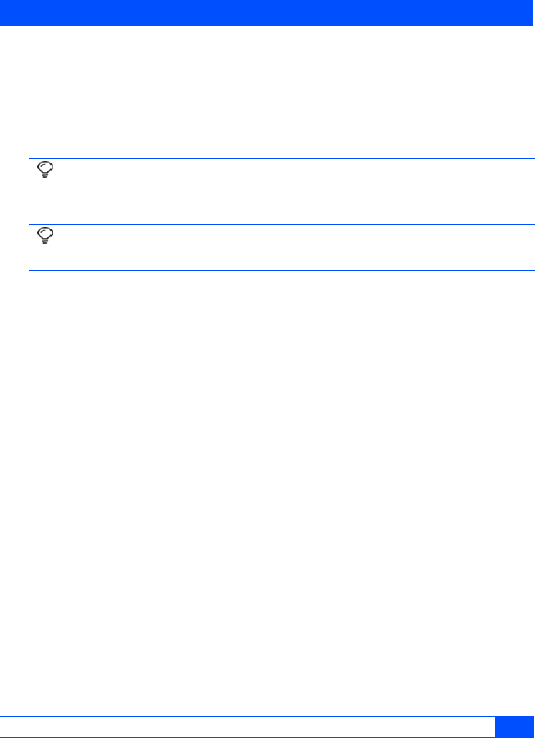
WEB BROWSER < MAIN MENU 37
-Reset Settings: reset settings.
You shall follow the steps below prior to using WAP functions:
1. Apply for WAP services; contact your network service provider for specifics of
WAP services.
2. Make necessary WAP setting on your MP by referring to the data statistic setting
or proxy.
Activate WAP browsing webpage:
1. In the idle screen, press [RSK] to enter into WAP home page.
2. In the idle screen, press [LSK] to enter into the menu, press [Direction
navigation key] to scroll to [Web browse], then press [OK] for confirmation (or
directly press [number key 3]) to enter into WAP application.
3. You can expediently access Internet by home page. The home page provides
home page URL and correct name, the home page is default as
"MONTERNET".
1.History
Display the address list of web pages lately browsed. When the cursor is in a web page,
select the menu in the interface to pop up the options below:
1. Go To: display the web page.
2. Delete: delete the web page.
3. Delete All: delete all web pages.
4. Show Address: display the web page address.
2.Bookmark List
The bookmark can store interested websites, and can be configured freely for easy
memorization. When the cursor is in a web page, select the menu in the interface to pop up
the options below:
3.3 Web browser
Caution: If you fold the MP during WAP via Pocket Switch Data, the
communication will be interrupted regardless of earphone Handset
Connector connected or not.
Caution: You can download video or sound up to 500KB by WAP browser. For
downloaded picture, the maximum size is 300KB.

38 MAIN MENU > WEB BROWSER
1. Go to: display the web page.
2. Edit: edit the title and address of the web page.
3. Delete: delete the web page.
4. Delete all: delete all web pages.
5. Show Address: display the web page address.
3.Page Memo List
Store web pages browsed and stored; when the cursor is in a web page, select the menu in
the interface to pop up the options below:
1. Show: display the web page.
2. Edit Title: edit the title of the web page.
3. Delete: delete the web page other than the protected page.
4. Delete All: delete all web pages.
5. Show Address: display the web page address.
6. Protect On/Off: configure whether to activate protection; in case the protected
pages exceed the maximum setting, you shall not configure protection.
7. Unprotect All: cancel all protection setting of pages.
4.Push Messages
Store received Push messages, and can browse them.
5.Options
1. Home: edit address and set as home, configure home page address.
2. View: configure view format, script text, animation, picture and table.
3. Proxy: configure the use of proxy and proxy server address; input IP address in
the proxy server address, input port or select HTTP1.1.
4. Cache: Cache Mode, Use DiskCache and Clear DiskCache.
5. Cookies: Cookies refer to the trivial information from the server to store your
access to WAP websites. If you agree to receive Cookies, the server will inquire
about your use of WAP website, interested contents and desired contents.
Cookie Mode: select one from 3 options, i.e. Accept All, Reject All and Prompt.
Delete All: delete all Cookies.
6. Certificates: display certificate information
7. Push Settings: select whether to receive Push messages.
8. Browsing Mode: select display browser mode
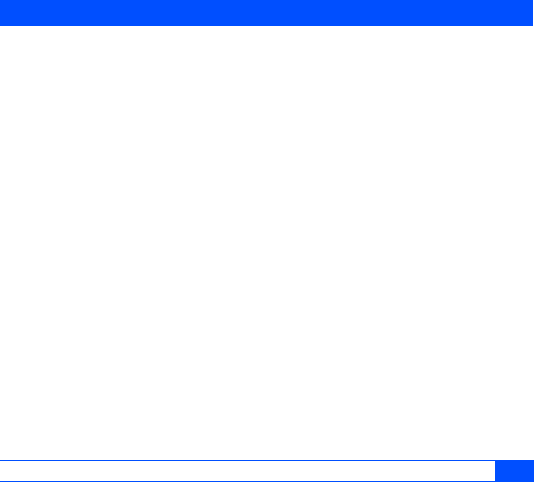
PHONE BOOK < MAIN MENU 39
9. Show All: display all configured information.
10. Reset: restore initial setting.
About Browser: display browser version.
8.Exit
Exit the browser.
Browse the web page
Initiate WAP to browse web pages, the caption column in the window will display the title of
the web page, the right/LSK keys in the screen will prompt the operations, the contents are
displayed in the middle and the underlined text refers to the super linkage. Press [LSK] for
pop-up menu, press [Direction navigation key] to scroll among functions of "1 Home", "2
Go to Webpage", "3 History", "4 Add Bookmark", "5 Bookmark List", "6 Save Page", "7 Page
Memo List", "8 Push Messages", "9 Show Properties", "0 Save Image", " Reload", "
Encoding", " Options" and " Exit"
The phone book contains contact list, Service numbers, Fixed numbers, Own numbers and
call options.
1. In the idle screen, press right navigation key to the list menu.
2. In the menu mode, press [Direction navigation key] to scroll to [4 phone
book], then press [OK] for confirmation (or directly press [number key 4]).
The contact list records the information of contacts, including names, number, mobile
number and etc and input the contact information is for calling and sending short messages.
You can store the phone book or the names to the phone storage (internal phone book) or
SIM card (SIM phone book). The internal phone book (phone) can store 500 items of
numbers, and SIM card storage capacity varies with the types.
1.Add new contact
In the "Add new contact" window, first select the new records to be stored in Phone/SIM card
then enter into new contact screen.
1. If Phone: input name, group, mobile/home numbers, office number, email,
memo, portrait and location.
2. If SIM card: input name, a number and location
3.4 Phone Book

40 MAIN MENU > PHONE BOOK
Input name and mailbox, enter into the text editing window; input other phone numbers,
enter into the number-input window, select the group to enter into the group names list
window and then press [OK]. If you do not select group when creating record, you will be
divided into the ordinary group. Enter into [my data] [picture] list to edit and pre-view the
head portrait.
2.View all contacts
Display all contacts stored in the Phone and SIM card.
Press [Direction navigation key] to select contact items by up/down scrolling or paging,
then confirm by pressing [OK], display detailed information of the contact; press [Dial key]
to dial the contact; select [LSK] for pop-up menu; press [Direction navigation key] for
scrolling selection of Find by, Add new contact, Voice call, video call, delete, copy, delete all,
copy all, Multi-delete, Multi-copy, group, Memory status.
3.Phone contacts
Display contact list stored in the phone.
Press [Direction navigation key] to select contact items by up/down scrolling or paging,
then confirm by pressing [OK], display detailed information of the contact; press [Dial key]
to dial the contact; select [LSK] for pop-up menu; press [Direction navigation key] for
scrolling selection of Find by, Add new contact, Voice call, video call, delete, copy, delete all,
copy all, Multi-delete, Multi-copy, group, Memory status.
4.SIM contacts
Display the contact list stored in SIM card.
Press [Direction navigation key] to select contact items by up/down scrolling or paging,
then confirm by pressing [OK], display detailed information of the contact; press [Dial key]
to dial the contact; select [LSK] for pop-up menu; press [Direction navigation key] for
scrolling selection of Find by, Add new contact, Voice call, video call, delete, copy, delete all,
copy all, Multi-delete, Multi-copy, group, Memory status.
1. Find by
In "contact lists" screen, select [LSK] to pop up the menu, press [Direction
navigation key] for scrolling selection of "Find by".
You may select:
-Name: input key characters in the input window, search for the numbers of
designated character string in the contact name list;
-Number: input key numbers in the input window, search for the numbers of
designated character string in the contact name list;

PHONE BOOK < MAIN MENU 41
-Memo: input key characters in the input window, search for the numbers of
designated character string in the contact name list;
-SIM location: input designated numbers in the input window, search for the
contact of designated position from all contacts stored in SIM card;
-Phone location: input designated numbers in the input window, search for the
contact of designated position from all contacts stored in phone;
-Group: select a group, search for all contact records of the group.
2. Add new contact
In the "Add new contact" window, first select the new records to be stored in Phone/
SIM card, and then enter into new contact screen.
-If Phone: input name, group, mobile/home numbers, office number, email, memo,
portrait and location.
- If SIM card: input name, a number and location
Input name and mailbox, enter into the text editing window; input other phone numbers,
enter into the number-input window, select the group to enter into the group names list
window and then press [OK]. If you do not select group when creating record, you will
be divided into the ordinary group. Enter into [my data] [picture] list to edit and pre-
view the head portrait.
3. Voice call
Dial the selected number for voice session.
4. Video call
Dial the selected number for video session.
5. Delete (Delete/Delete all/Multi-Delete)
Delete one, more than one or all contact records.
6. Copy (copy/copy all/Multi- Copy)
Copy one or more than one or all contact records from SIM card to phone or from
phone to SIM card.
7. Group
You can devide the contacts stored in the phone into groups, such as "general",
"business" or "family". This MP pre-sets 6 fixed contact groups and 2 defined groups.
8. Memory status
The MP is equipped with memory status inquiry function to enable you to understand
the operation status of the MP. The storage status inquiry primarily covers recording

42 MAIN MENU > PHONE BOOK
capacity in SIM card, phone, Fixed numbers, Service numbers and the used
capacity.
9. Function menu of contact details
In contact list, select the highlighted item, the screen will display detailed contact
information; select [LSK] for pop-up menu, press [Direction navigation key] to
select:
- Edit: edit all items.
- Voice call: audio dial the selected number.
- Video call: video dial the selected number.
- Create message: send SMS/MMS to selected numbers
- Delete: delete undesired numbers.
- Copy: copy to SIM/Phone.
10.Function menu of create message
In create message screen, there are two menu items:
- SMS: send short message to selected numbers.
- MMS: send SMIL to selected numbers.
5.Service numbers
Service number dialing. The number stored in the directory is provided by your network
service provider. It will call the service provider for such service. The number is preset in the
SIM card, please contact your network service provider.
6.Fixed numbers
Fixed number dialing. The function means that you can dial the numbers stored in the Fixed
numbers list; with Fixed Numbers function on, you can only dial the numbers in Fixed
numbers list and emergency numbers.
7.View own number
For user setting of local number stored in SIM card, input two names and numbers.
Local number stores user numbers; automatically into the number input window, you can
edit and modify the numbers.
8.Call options
The session record records the missed number, received number, dialed number and
session duration, and can delete records.
The session record has 2 contents, call history and total calls duration. In call history
content, there are 3 contents, dialed calls, received calls and missed calls.

CAMERA < MAIN MENU 43
To operate the selected number in inquiry, press [LSK] for pop-up menu to execute the
functions like save, Create message, voice call, video call, delete, delete all or press
[OK] for detailed information
including name, number, time, date, session duration.
-Save: store desired contents to the phone book.
-Create message: send SMS/MMS to selected numbers.
-Voice call: audio dial selected number.
-Video call: video dial selected number.
-Delete: delete undesired contents.
-Delete all: delete all contents in the contact list.
Function menu of create message
In create message screen, there are two menu items:
-SMS: send short message to selected numbers.
-MMS: send SMIL to selected numbers.
You can take pictures or film of those around you, which can be automatically stored in "my
data". The pictures can be sent to others by MMS. You can use the picture as the wall paper,
or configure the picture as the head portrait of certain contact in the phone book. The picture
and film are stored in Jpeg and 3GP format.
1. Initiate camera/shooting function
1. In idle screen, hold [Side key] for taking pictures.
2. In idle screen, press [LSK] to enter into the menu, the cursor-lined option is
[camera], then press [OK] to confirm (or directly press [number key 5]), enter
into camera menu interface, press [OK] to initiate camera function.
3.5 Camera
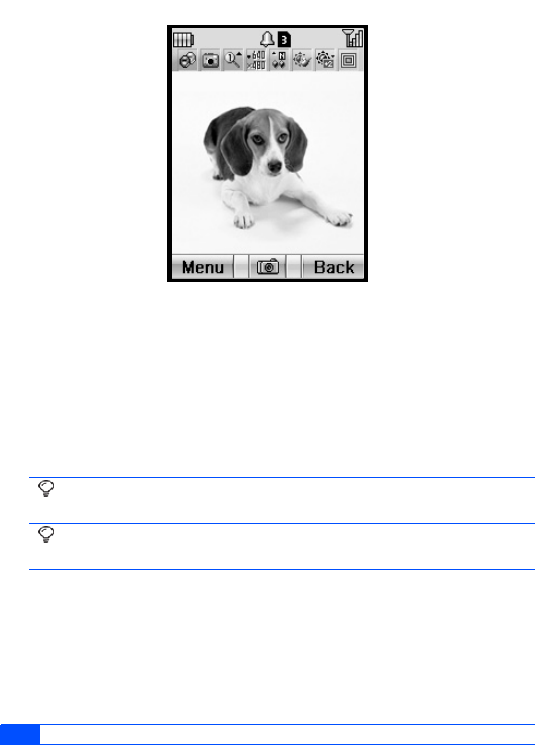
44 MAIN MENU > CAMERA
2. Taking pictures
Initiate camera function, enter into the view frame as shown in figure 1.
- In the camera view-finding screen, adjust camera position to display the object on the
screen.
- In the camera view-finding screen, the illumination shall be always light and the color
of the light is blue.
- Keep the lens fixed, then press [OK] or press [Side key]. When you shutter, the
illumination shall be light and the color of the light is red.
1.Zoom
In view-finding screen, press [up and down navigation key] to adjust focus.
2.Adjust brightness
In view-finding screen, press [left/right navigation key] to adjust brightness.
Caution: If you fold the MP in the camera view-finding screen, it shall close the
screen.
Caution: During self-timer countdown, the illumination shall blink with
countdown sound and the color of light is green.
Figure 1

CAMERA < MAIN MENU 45
3.Camera function options
Prior to taking pictures
In view-finding screen, press [LSK] to pop up the menu, then press required key for
desired options.
Front camera: when the view frame adopts front lens/back lens, the item in the
menu display back lens/front lens; when selecting the item, return to
the view frame interface, which displays the view of back lens/front
lens.
Video mode: initiate video recorder function
Zoom: setting of focus adjustment levels, i.e. x1, x2 and x4;
Photo size: setting of picture sizes, i.e. VGA (640×480), CIF (352×288), Stand-
by (176×180), QCIF (176×144), CLI (120×120), SubQCIF(128×96).
Quality: 3 levels, Normal, Fine, and Super fine.
White balance: automatic, sunny, cloudy or indoors.
Filtering: setting of the display style, i.e. Normal, Sepia and Monochrome.
Shutter sound: No. 1, No. 2 and No. 3 tones (in meeting mode, the tone will
ring upon taking pictures or shooting)
Brightness: 5 levels, i.e. +2, +1, 0, -1, -2.
Shutter mode: setting of camera mode, i.e. normal, continuous, frame and self
shutter
Continuous: 2, 4, or 6.
Frame: in the modification option, press [up/down direction key] to browse all
frames, press [OK] to select desired frame.
Self shutter: take self pictures, configure time, i.e. 5 seconds, 10 seconds and
15 seconds.
End of taking pictures
After taking pictures, press [OK] to store with a default name provided by system
automatically.
You can also send your pictures out by pressing [LSK] to enter into MMS sending
interface to send out the picture.
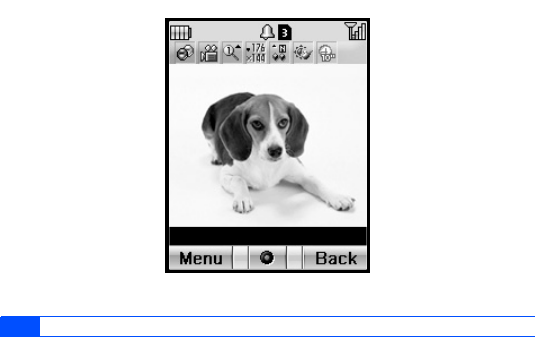
46 MAIN MENU > CAMERA
3. Shooting function options
Shooting a film
In the camera view-finding screen, the illumination shall be always light and the color of the
light is blue.
In the view frame screen, press [LSK] for pop-up menu, then press relevant keys for desired
options.
1. Front camera: when the view frame adopts front lens/back lens, the item in the
menu display back lens/front lens; when selecting the item, return to the view
frame interface, which displays the view of back lens/front lens.
2. Photo mode: initiate shooting function
3. Zoom: setting of focus adjustment levels, i.e. x1, x2 and x4;
4. Video size: setting of picture sizes, i.e. QCIF (176×144) and SubQCIF
(128×96).
5. Quality: 3 levels, normal, fine and super fine.
6. White balance: automatic, sunny, cloudy or indoors.
7. Video time: configure the longest time, i.e. 10 seconds, 30 seconds and 60
seconds.
In the view frame screen, shoot the film by pressing [OK] or [Side key] as shown in figure 2
below.
During shooting a film, the illumination shall blink and the color of the light is red.
Figure 2
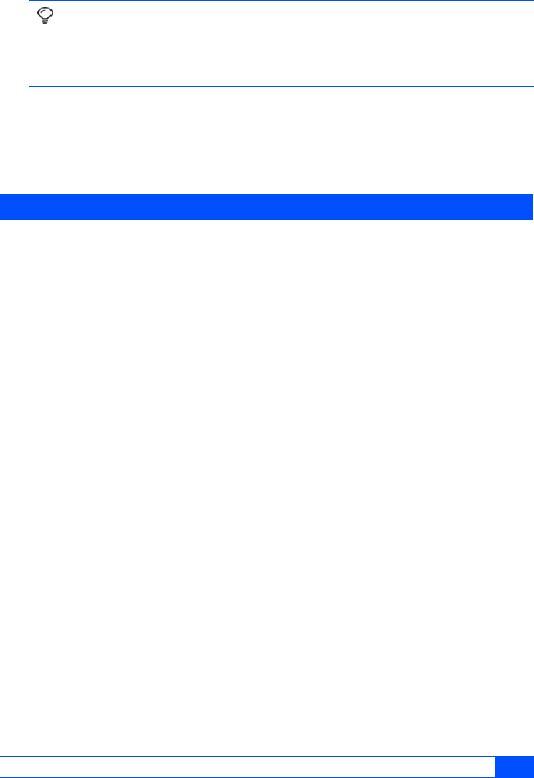
MY DATA < MAIN MENU 47
End of shooting
After shooting a film, press [OK] to store with a default name provided by system
automatically.You can also send your films out by pressing [LSK] to enter into SMIL sending
interface to send out the film.
In My Data menu, you can play sound, display pictures or short film or downloaded pictures,
View pictures or animations downloaded or from MMS. The MP can store 300 tones,
pictures or film clips up to 300 items in total excluding preinstalled files.
1. In the idle screen, press [LSK] to enter into the menu, press [Direction navigation
key] to scroll to [My Data], then press [OK] for confirmation.(or directly pressing
[number key 6]).In the idle screen, press [Down navigation key] to directly enter into
My Data interface.
1. Video
The folder stores the film clips; press [LSK] in the film list screen for options
below:
View: pre-view the film. The movie can be suspended by pressing [OK]
during playing then resume playing by pressing [OK] again.
Send by MMS: send the film out in the form of SMIL.
Rename: rename the film.
Sort by: queue the films as per name, size or date.
Delete: delete current files.
Delete all: delete all files.
Property: display file name, size, date and time etc.
Listing: setting of the list display manner, name or picture.
2. Sound
The folder stores sounds. Press [LSK] to select the options below.. For
embedded sounds some options below are gray.
Play: play the file.
Caution: During recording and there is unsaved data, when you close the fold,
MP shall stop the movie recorder then entry like pressing [OK]. If there
isn't unsaved data, when you close the fold, MP shall close the
viewfinder.
3.6 My Data

48 MAIN MENU > JAVA™
Send by MMS: send the sound out in the form of SMIL.
Rename: rename the sound.
Sort by: queue the sounds as per names, sizes and dates.
Delete: delete current files.
Delete all: delete all files.
Set as voice tone: configure current sound as the voice call tone.
Set as video tone: configure current sound as the video call tone.
Set as message tone: configure the sound as message tone.
Property: display file name, size, date and time etc.
3. Pictures
The folder stores pictures. Press [LSK] to select the options below. For
embedded pictures, some options below are gray.
View: pre-view the pictures.
Send by MMS: send the picture out in the form of MMS.
Rename: rename the picture.
Sort by: queue the pictures as per names, sizes and dates.
Delete: delete current files.
Delete all: delete all files.
Property: display file name, size, date and time.
Listing: setting of the list display manner, name or sketch.
4. Others
Store the text downloaded and from MMS.
5. Memory status
You can review the storage status, including the storage capacity which
pictures, videos, sound and others occupy respectively, total capacity and
remaining capacity.
You can download Java program from the website, and operate it on your MP.
1. In the idle screen, press [LSK] to enter into the menu.
2. Press [Direction navigation key] to scroll to [Java™], then press [OK] for
confirmation (or directly press [number key 7]). Display Java application list in your MP,
you can press [up and down navigation key] to display all application programs. (In
3.7 Java™

JAVA™ < MAIN MENU 49
the idle screen, hold [RSK] (over 2 seconds) to display Java application list)
1. Execute Java program
In Java program list interface, when the desired application program is
highlighted, press [OK] to operate the Java program.
2. Update Java program
In Java program list interface, press [LSK] for pop-up menu, select Update to
update the current Java program.
3. Delete, Select Delete Java program
In Java program list interface, press [LSK] for pop-up menu, select Delete to
delete the highlighted Java program.
4. Delete all Java programs
In Java program list interface, press [LSK] for pop-up menu, select Delete All
to delete all downloaded Java programs.
5. Create, Delete and Rename user-defined Folder
In Java program list interface, press [LSK] for pop-up menu, select Create
Folder to create the user-defined Folder in the root directory, or delete/
rename the Folder.
6. Move, Move All to the Folder
In Java program list interface, press [LSK] for pop-up menu, select Move To
Folder to move the highlighted Java program to designated Folder.
7. Sort
In Java program list interface, press [LSK] for pop-up menu, select Sort to
sort all Java programs in the order below:
- Name< Alphabetical order> (backward or forward)
- Date<Creation time> (backward or forward)
- Size (backward or forward)
- Exc Time<Operating time> (backward or forward)
- Exc Count<Operating count> (backward or forward)
8. Attribute
In Java program list interface, press [LSK] for pop-up menu, select Attribute
to review Java program information.
9. Permission
In Java program list interface, press [LSK] for pop-up menu, select
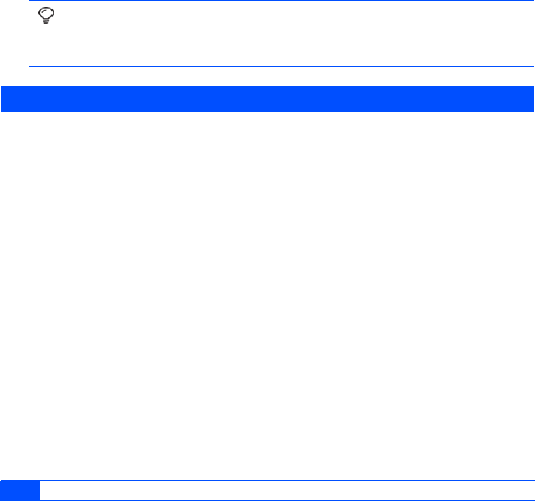
50 MAIN MENU > ACCESSORY
Permission to review the Permission of the program operating, you can
modify the Permission.
10.Proxy setting
In Java program list interface, press [LSK] for pop-up menu, select Proxy
setting to review the Proxy setting screen.
You can configure the use of proxy and proxy server address for Java
Application Manager and Java Application; input IP address in the proxy
server address, input port.
11.System info
In Java program list interface, press [LSK] for pop-up menu, select System
Information to review JV-Lite2 system information, including version, size,
occupied storage capacity and remaining capacity.
There are some common applications in the Accessory.
1. In the idle screen, press [LSK] to enter into the menu.
2. Press [Direction navigation key] to scroll to [Accessory], then press [OK]
for confirmation (or directly press [number key 8]).
3. If the MP is power off, it's noneffective when alarm or schedule time is
arriving.
1. Alarm Clock
1. In "Accessory" list, select "clock alarm", display 3 alarm clock lists.
2. Select one alarm clock for specific setting.
-Set time: set alarm ring time.
-Period: input alarm clock time.- Cycle setting: select [once /everyday/
weekly].
-Ring: change the prompt tone of alarm clock.
-Rename: change the name of alarm clock.
Caution: After downloading Java application program, be sure to review the
contents in application program list to confirm the successful
download. Otherwise, the downloaded Java program may be lost.
3.8 Accessory
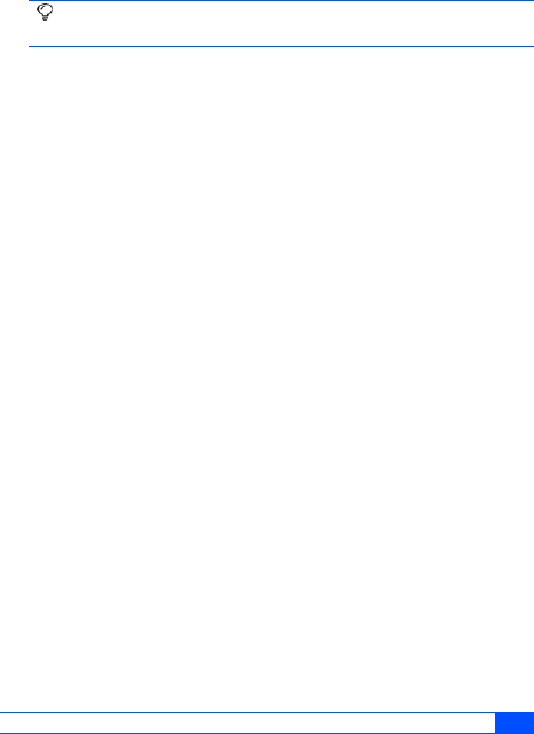
ACCESSORY < MAIN MENU 51
-Status: activate or deactivate alarm clock. Above operations also apply to
setting of "alarm clock 2" and "alarm clock 3".
2. Schedule
1. In "Accessory" list, press [Direction navigation key] to scroll to "schedule",
then press [OK] for confirmation to schedule and record the planned affairs.
At the scheduled time, your MP will send out prompt tone to notify you.
2. In calendar, display current date; press [Direction navigation key] to move
the icon to select desired dates, the caption column provides the calendar
year and month of the current date. The date of scheduled event will be
displayed in orange (others in black).
3. When selecting a day, press [OK] to see the arrangement;
4. In the calendar interface, press [LSK] pop-up menu, press [Direction
navigation key] to scroll to "New", then press [OK] for confirmation, display
new screen.
-Date: input scheduled date.
-Time: setting of scheduled prompt time.
-ALM time: set the alarm time. i.e. At the set time, 5 minutes before, 10
minutes before, 20 minutes before, 30 minutes before, One hour before, 90
minutes before, Two hours before.
-Memo: in the text input interface, input the event of the created schedule.
-Ring: setting of prompt tone.
-Repeat: select [once, daily, weekly, monthly].
-Status: activate or deactivate the schedule.
5. In the calendar screen, press [LSK] pop-up menu, press [direction
navigation key] to scroll to "select date", then press [OK] for confirmation,
the screen plays a date selection block, you can edit dates and inquire about
the schedule.
6. In the calendar screen, press [LSK] pop-up menu, press [direction
navigation key] to scroll to "list all", then press [OK] for confirmation, display
Caution: The above function is available when MP is on, otherwise the alarm
clock will not operate.

52 MAIN MENU > ACCESSORY
the schedules of all dates, you can view, edit or delete in the same steps of
"new schedule".
7. At the scheduled prompt date, the MP will play the event tone (if configured)
and the prompt picture; browse the schedule, the content will scroll out.
3. Calculator
1. In "Accessory" list, press [direction navigation key] to scroll to "calculator",
then press [OK] for confirmation, enter into the calculator screen for simple
arithmetic.
2. You can directly input the numbers for calculation, press [direction
navigation key] to switch over the calculation rules.
3. Press [OK] to display calculation result, press [LSK] to clear off.
4. Press [RSK] to exit to "Calculator" screen.
4. Currency exchange
1. In "Accessory" list, press [direction navigation key] to scroll to "Currency
exchange", then press [OK] for confirmation, exchange the given amount of
currency into the currencies of other nations or regions.
2. Press [direction navigation key] to enter into the list, select "exchange
currency", in, "From" item , select "target currency in "To" item", then write
"exchange rate" in "Rate" item and write "amount" in "Amount" item.
3. The screen will display result.
4. Press [RSK] to exit to "Currency exchange" screen.
5. PC synchronization
PC Tool is a convenience function for user. It can transfer data in phonebook or other rings
and pictures that user prefer by data line which is a special accessory.
Steps to use it:
1. If you want to use it, firstly, you should setup drive and synchronization
software for it in your computer. Windows 2000 Professional and Windows XP
operating systems are all OK.
2. Secondly, enter the main menu in MP, then choose accessory and set data
transfer function on.

SIM TOOLKIT < MAIN MENU 53
3. Thirdly, connect your computer and your MP with PC Tool data line.
STK is provided by service provider. If your MP SIM supports STK, you can see STK menu.
The menu name and contents depend on the contents provided by service provider. Please
contact your service provider to know about the details of STK.
SIM toolkit display will vary with SIM cards.
1. In the idle screen, press [LSK] to enter into the menu.
2. Press [direction navigation key] to scroll to [SIM-toolkit], press [OK] for
confirmation (or directly press [number key 9]).
Note: If it doesn't include PC Tool data line when you buy it, you can order it from
provider.
3.9 SIM toolkit
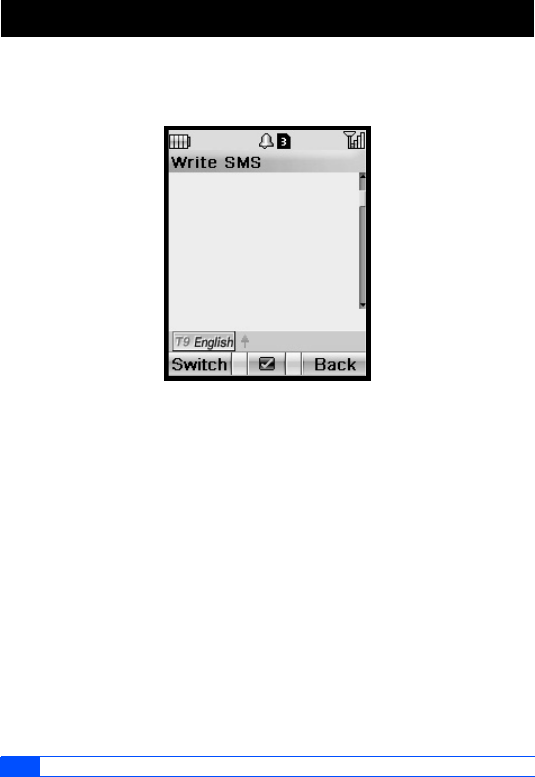
54 REFERENCE INFORMATION >
Input Text
The MP provides many kinds of expedient text input methods matching other functions,
including T9 English, T9 Italian, ABC, 123 number input methods.
- English/ Italian input: press [LSK] to switch over the input methods, select "T9
English". In English imagination mode, input the letters by the keyboard, one screen
displays one English word, press [Upper navigation key] to display the last word,
press [Down navigation key] to display the next word; press [OK] for confirmation, the
word will be displayed on the cursor of the input column. Press [* key] to switch over the
input methods within "abc", "Abc" or "ABC". "T9 Italian" shares identical input methods
with "T9 English".
-Letter input: press [LSK] to switch over the input methods, select "ABC", input letters
by number keys on the keyboard; press keys to input the letters, the letters or numbers
will display on the cursor of the input column Press [* key] to switch over the input
methods within "abc", "Abc" or "ABC".
-Number input: press [LSK] to switch over the input methods, select "123", input the
numbers by [number key] on the keyboard.
-Symbol input: in the text input screen, press [# key] to enter into the symbol input
mode, select more symbols by [upper navigation key] or [down navigation key], input
the symbols by corresponding [number key] or [OK].
4. Reference Information
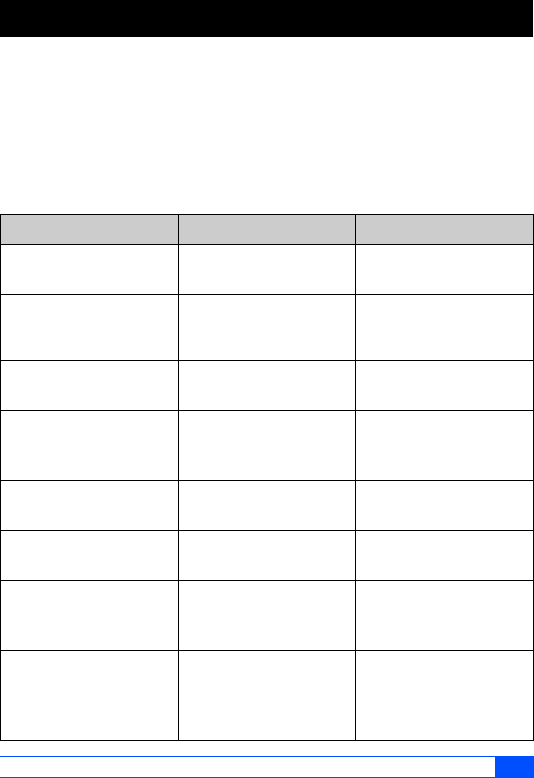
< REPAIR GUIDELINE 55
You are welcome to use the MP produced by NEC. In case of any problem of e373 MP in
use, please contact the distributor or NEC repair center. In case of repair, please send your
MP to local repair station (see the Warranty Certificate attached with MP); in case of no
repair station locally, please send your MP and duplicate invoice to the distributor for EMS.
To inquire about the latest repair outlet and replacement center address, please contact 800-
820-7007, or http://www.necmobile.com
5. Repair Guideline
Common problems Potential causes Solution
1. Weak signals Far away from base
station or strong insulation
Get near the windows or
corridors.
2. The screen will display
"no card" or "invalid
card"
Possibly dirty contact pad
of SIM card
Gently clean the contact
pad of SIM card.
3. Backlight constantly
light
Possibly configured
power-on backlight
Re-configure backlight
mode
4. Battery charged full
holds short
Possibly configured
power-on backlight, to
consume high electricity
Re-configure backlight
mode
5. Silent headphone Possibly configured
minimum volume
Adjust the volume by up/
down volume key
6. Only vibration no ring
upon incoming call
Possibly configure the MP
as Conference Mode
Re-configure "standard
mode"
7. No billing function
(AoC)
No such service of
domestic network at
present
Contact network service
provider
8. Fail to access WAP
network
Possibly wrong WAP
setting
Reset WAP Connection
setting in Phone settings,
or contact network service
provider